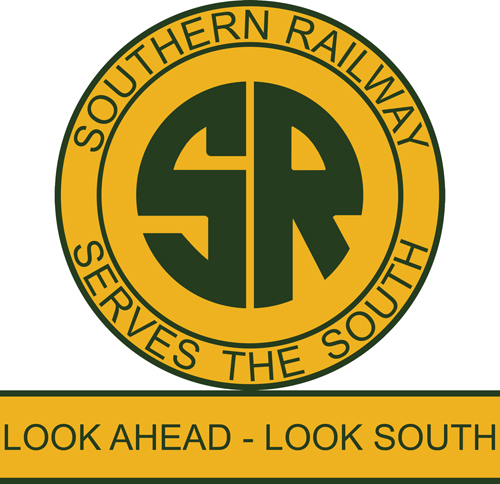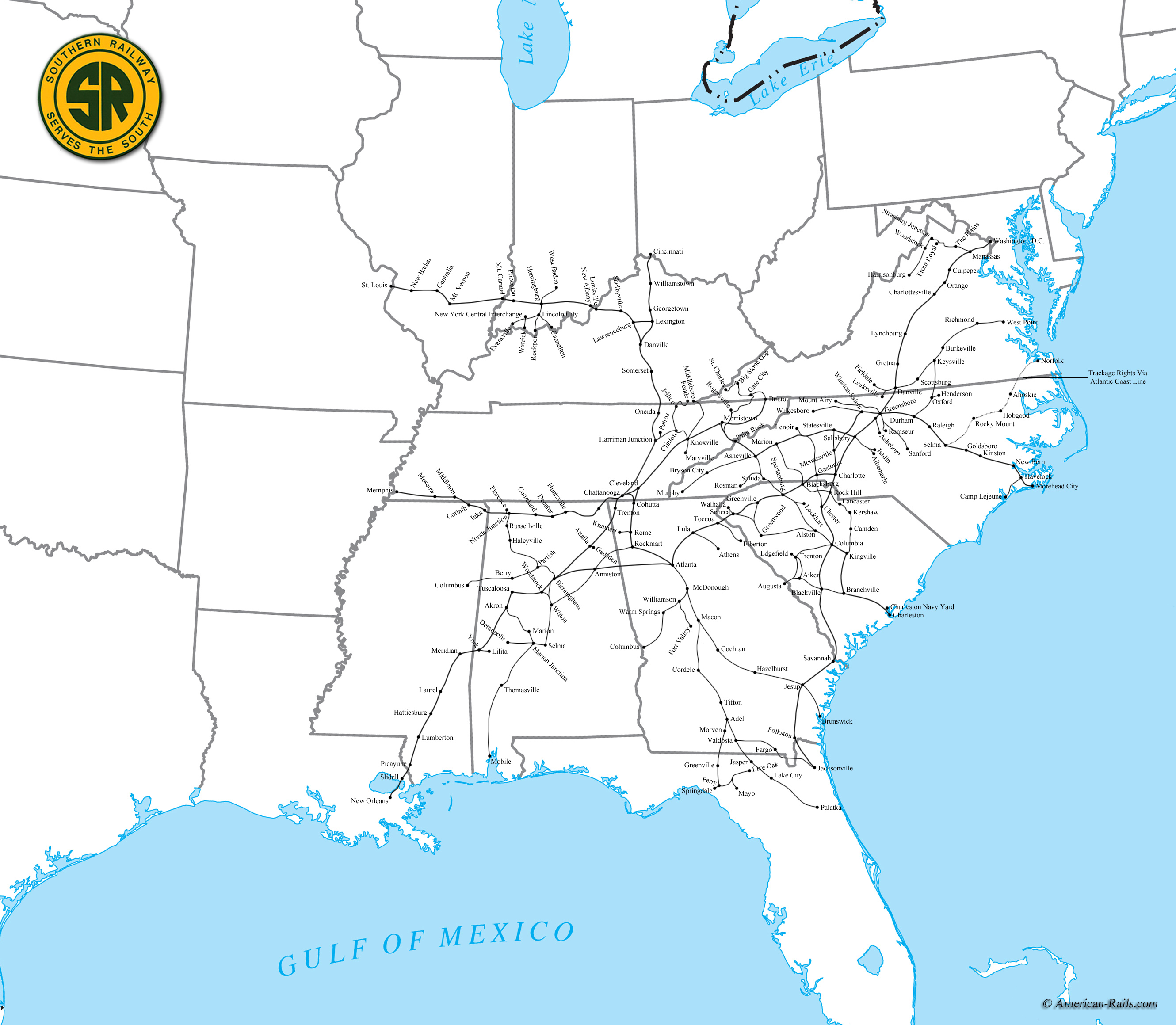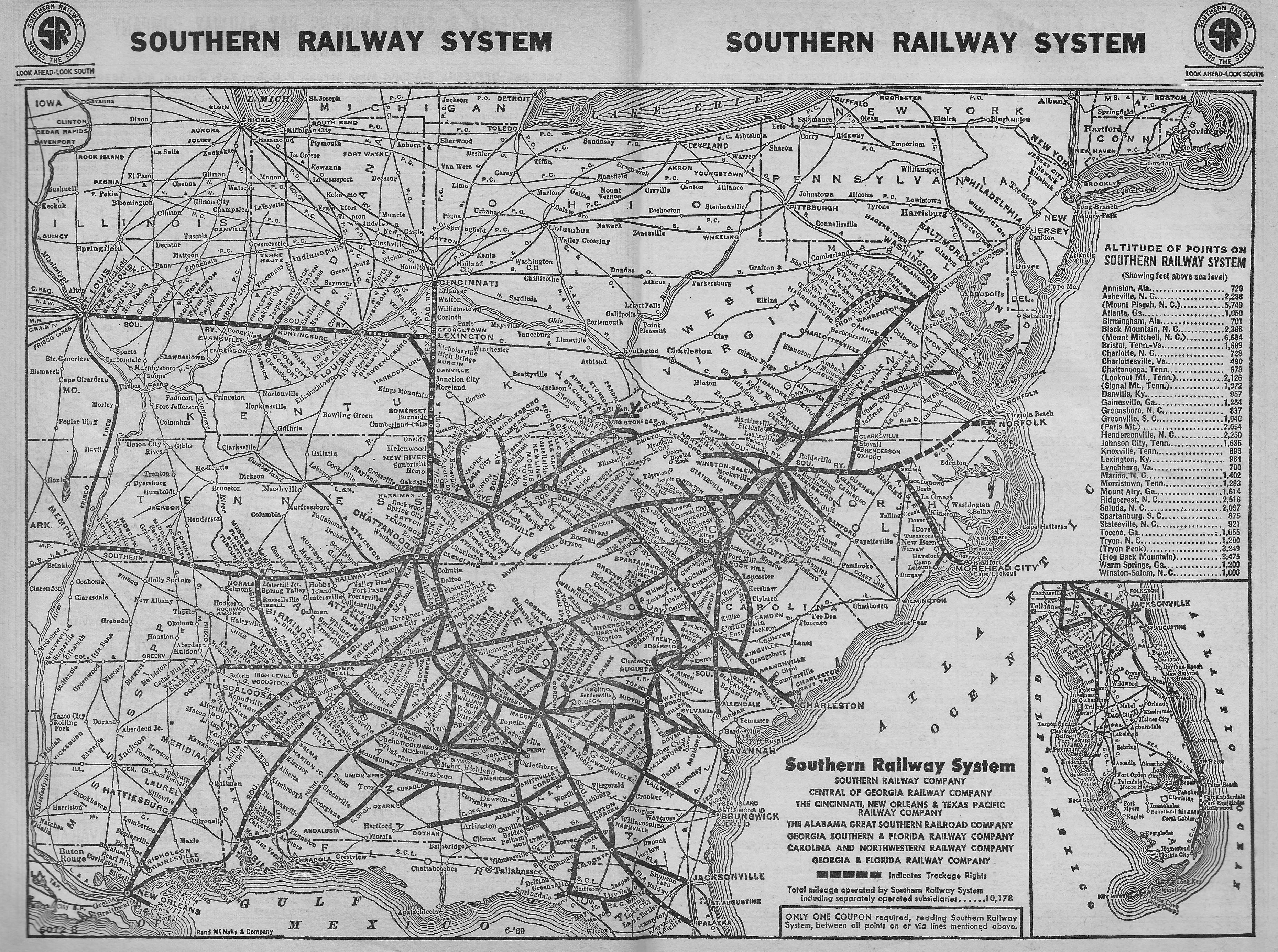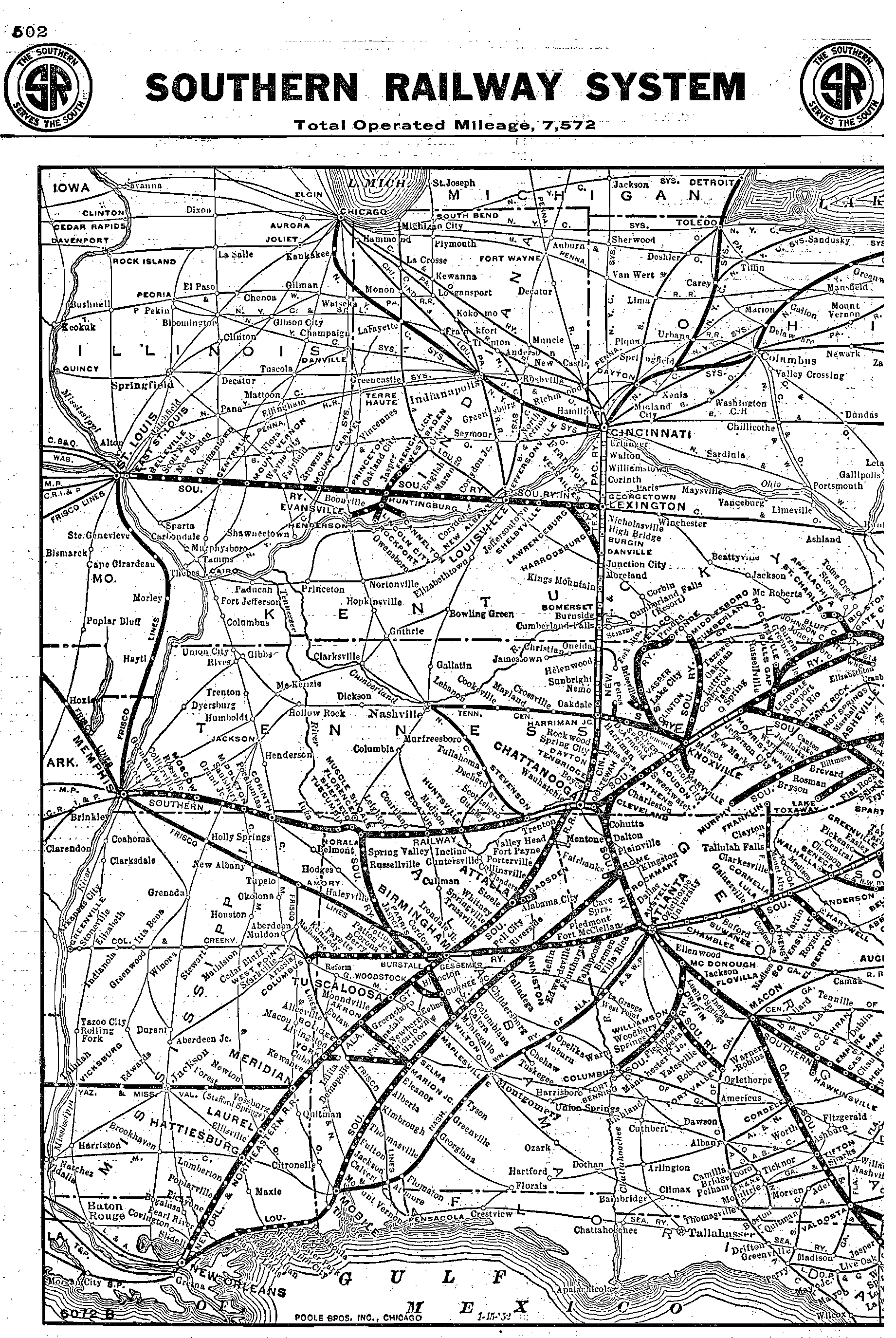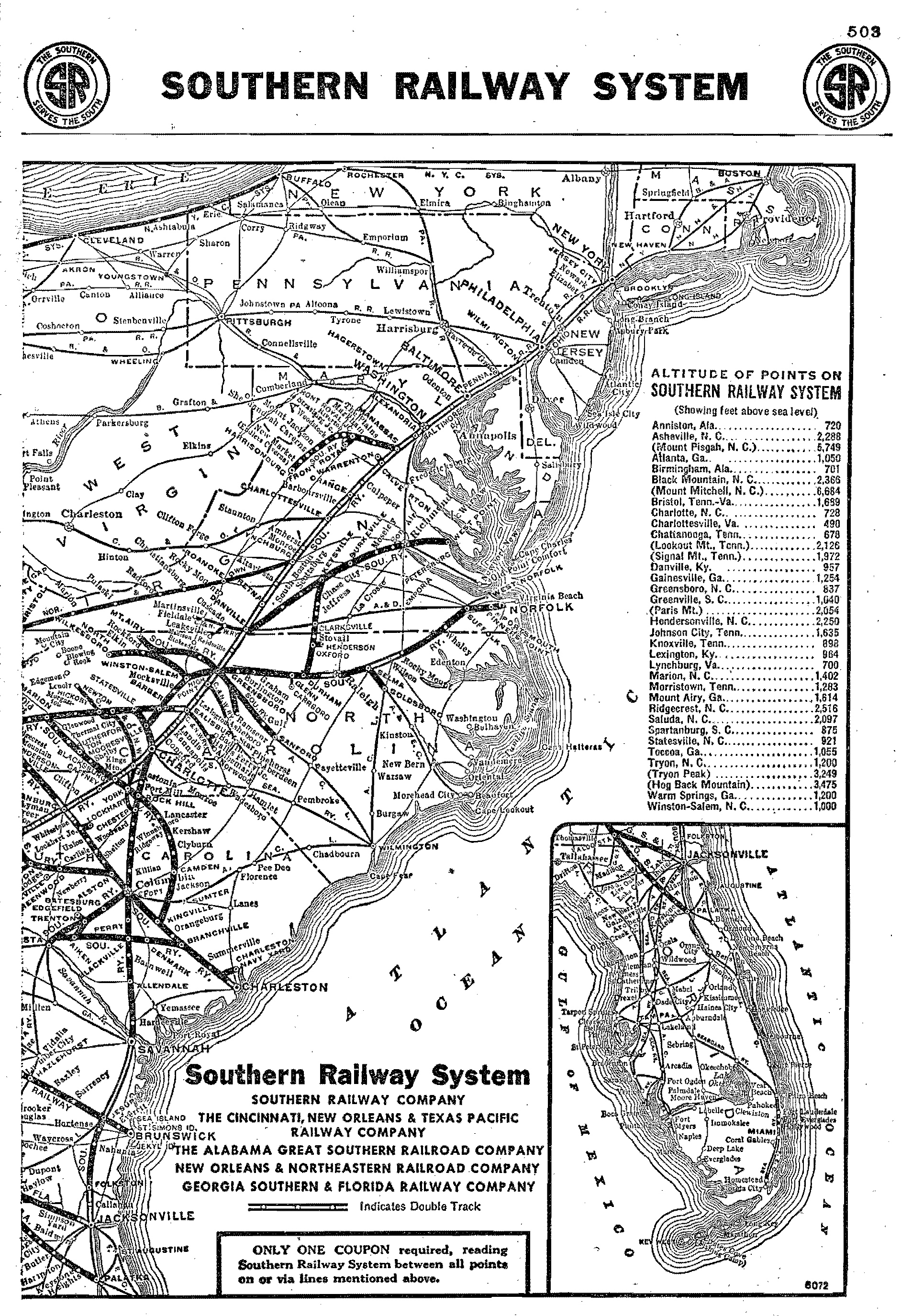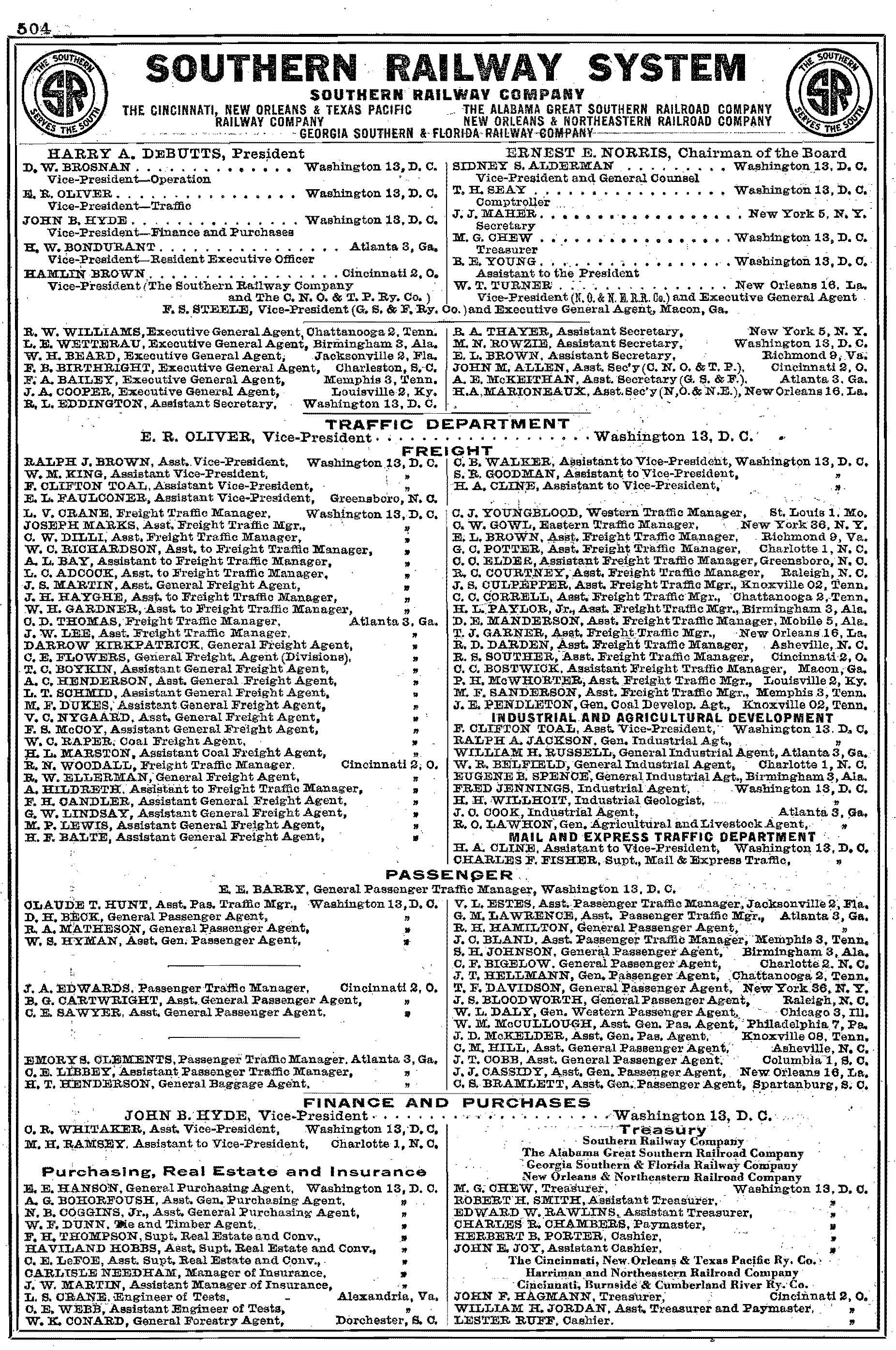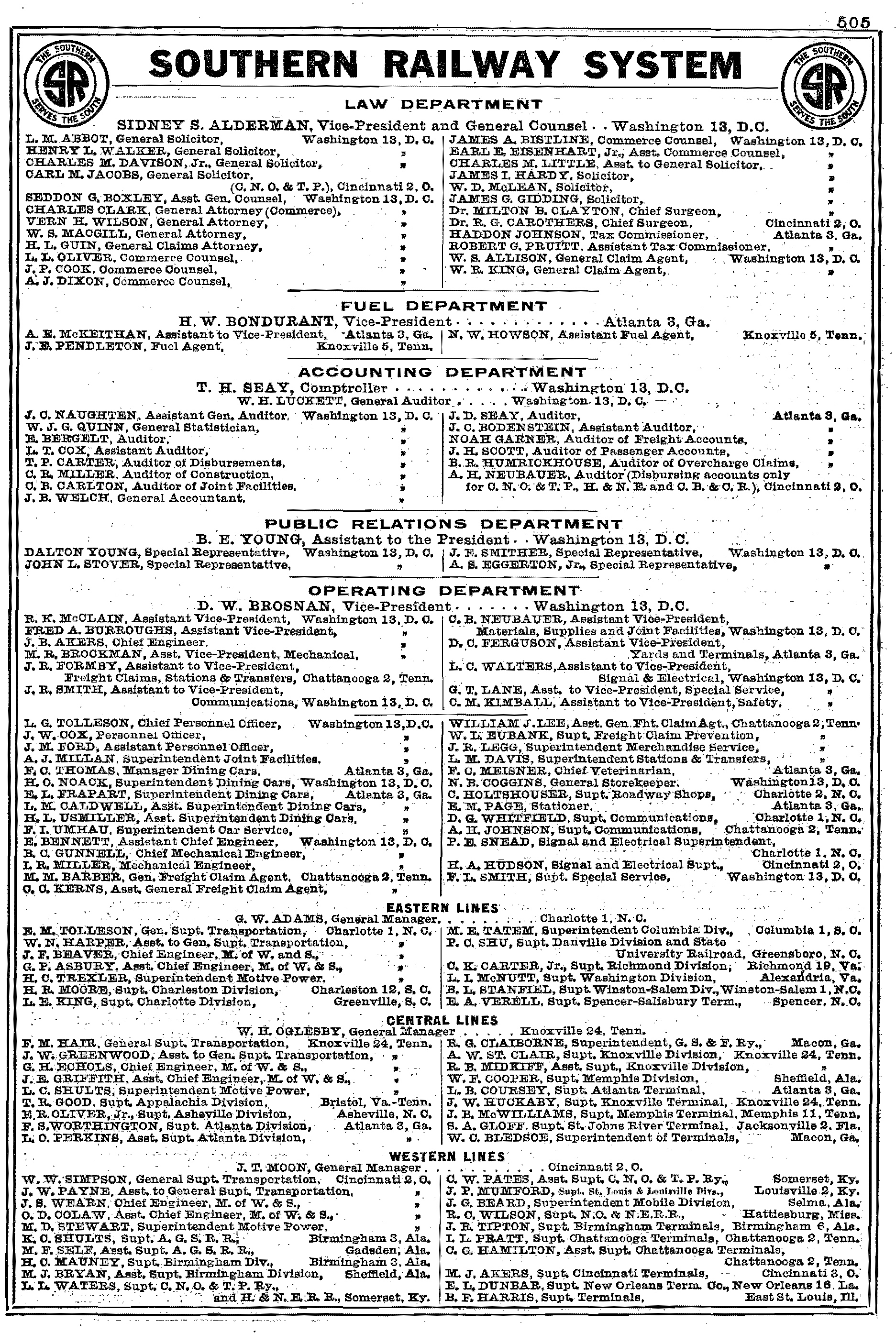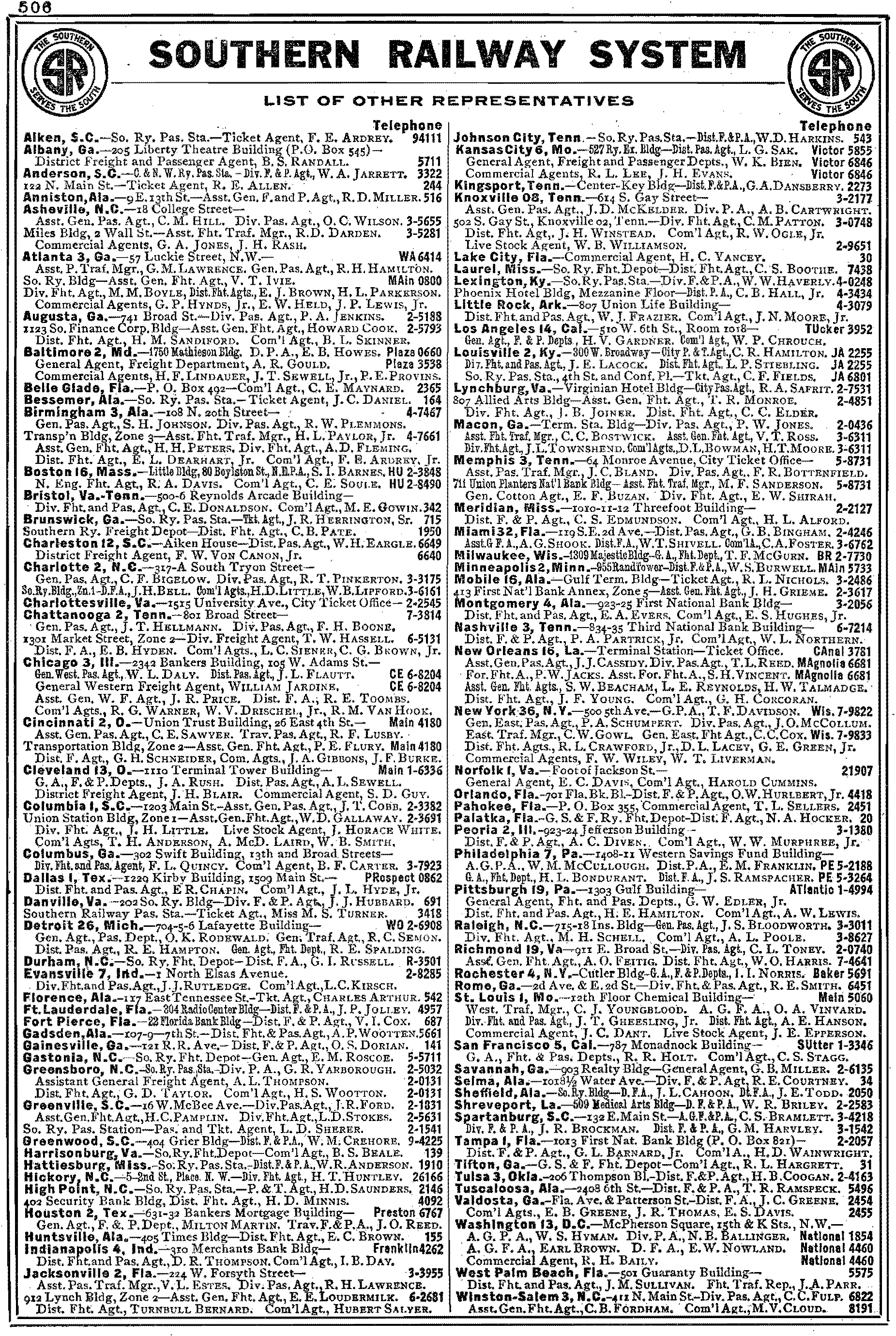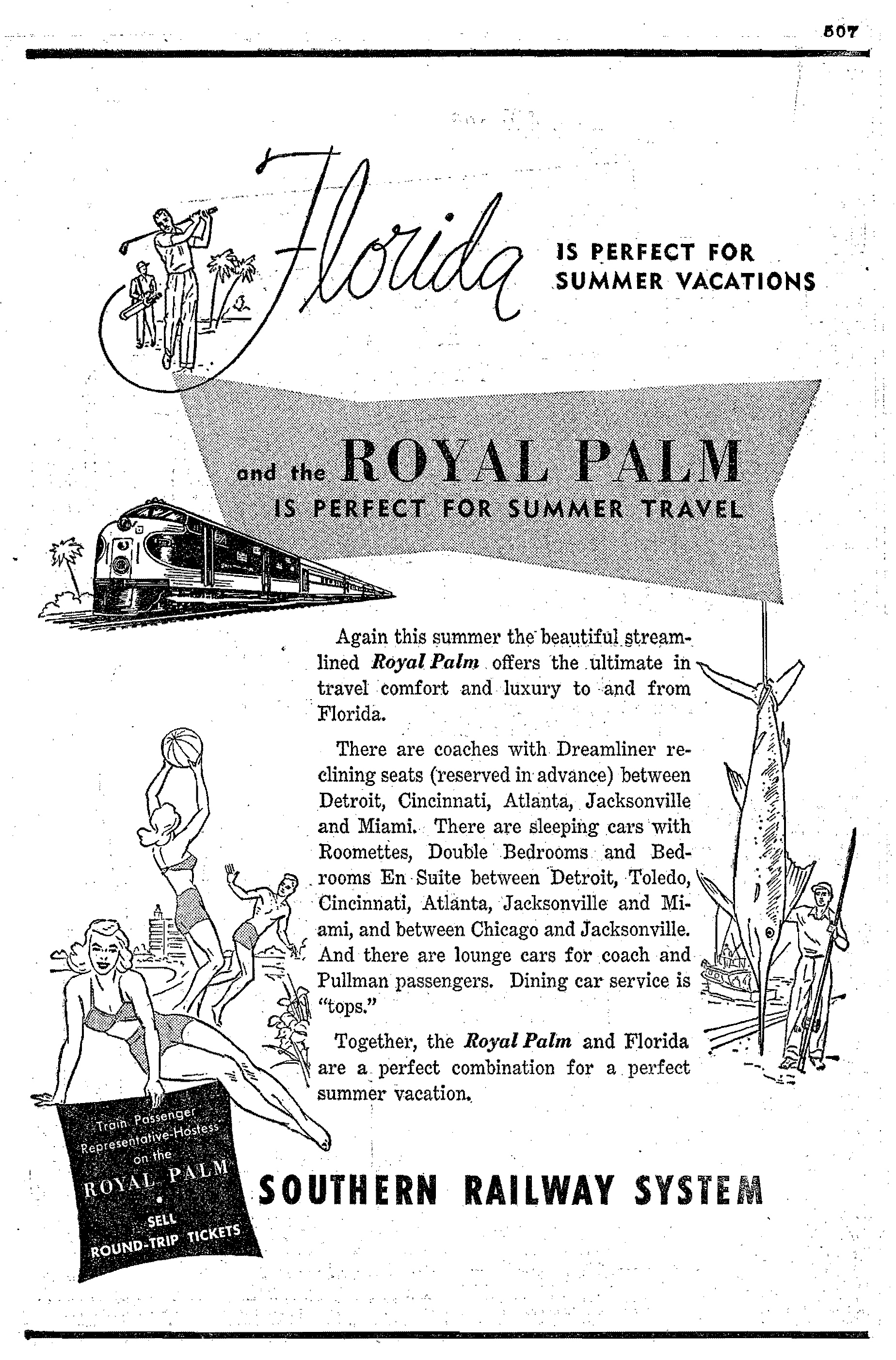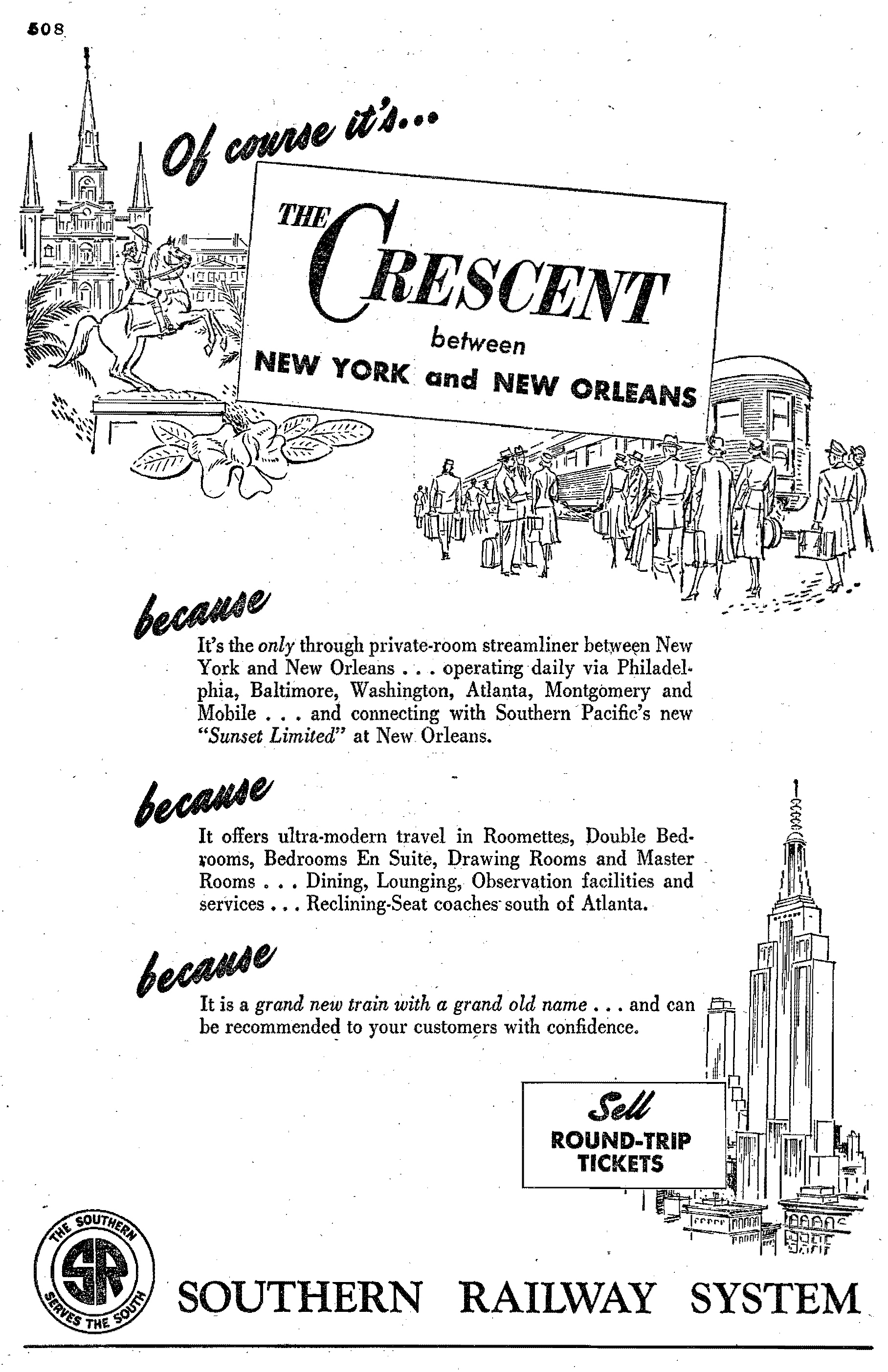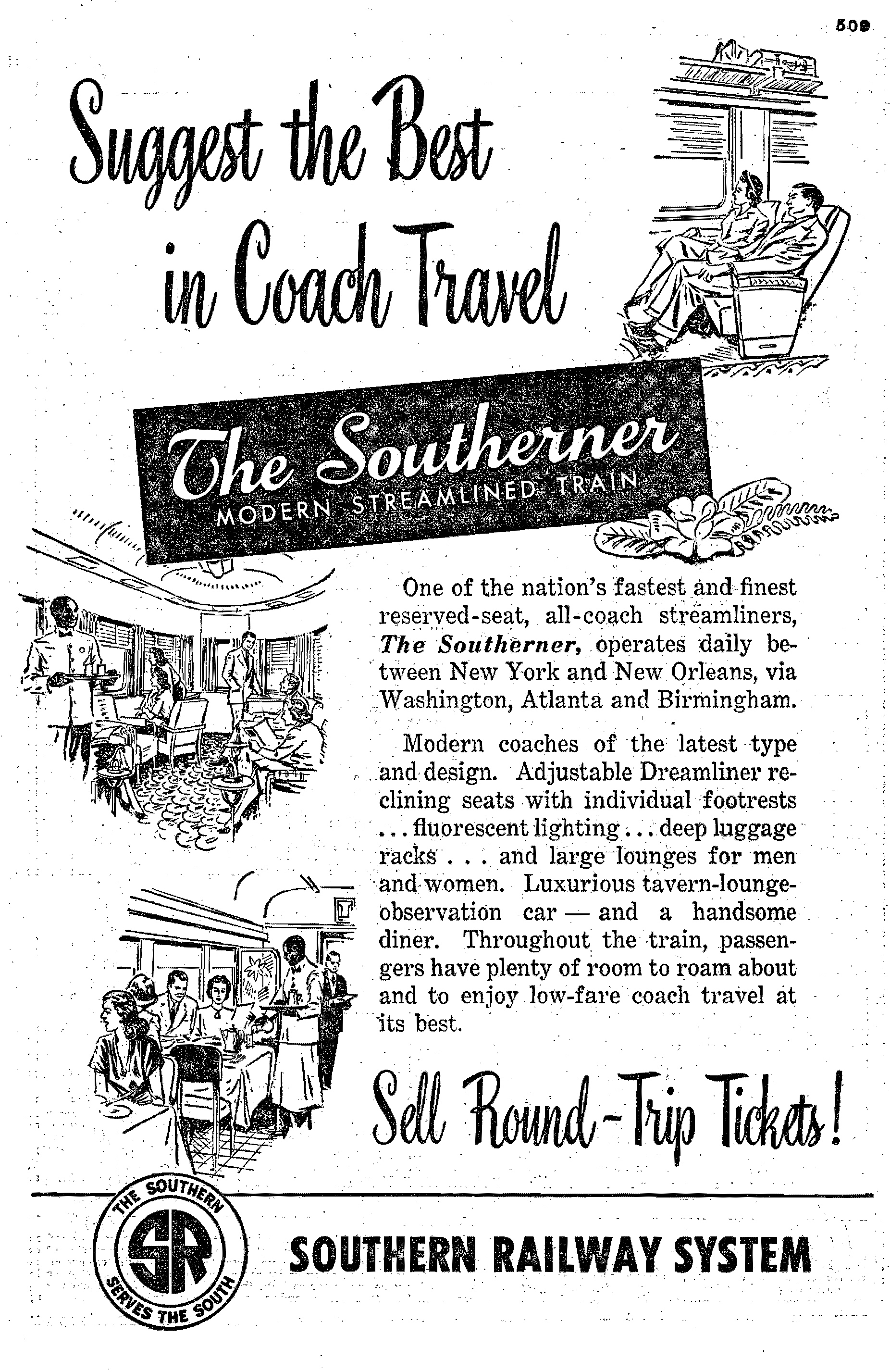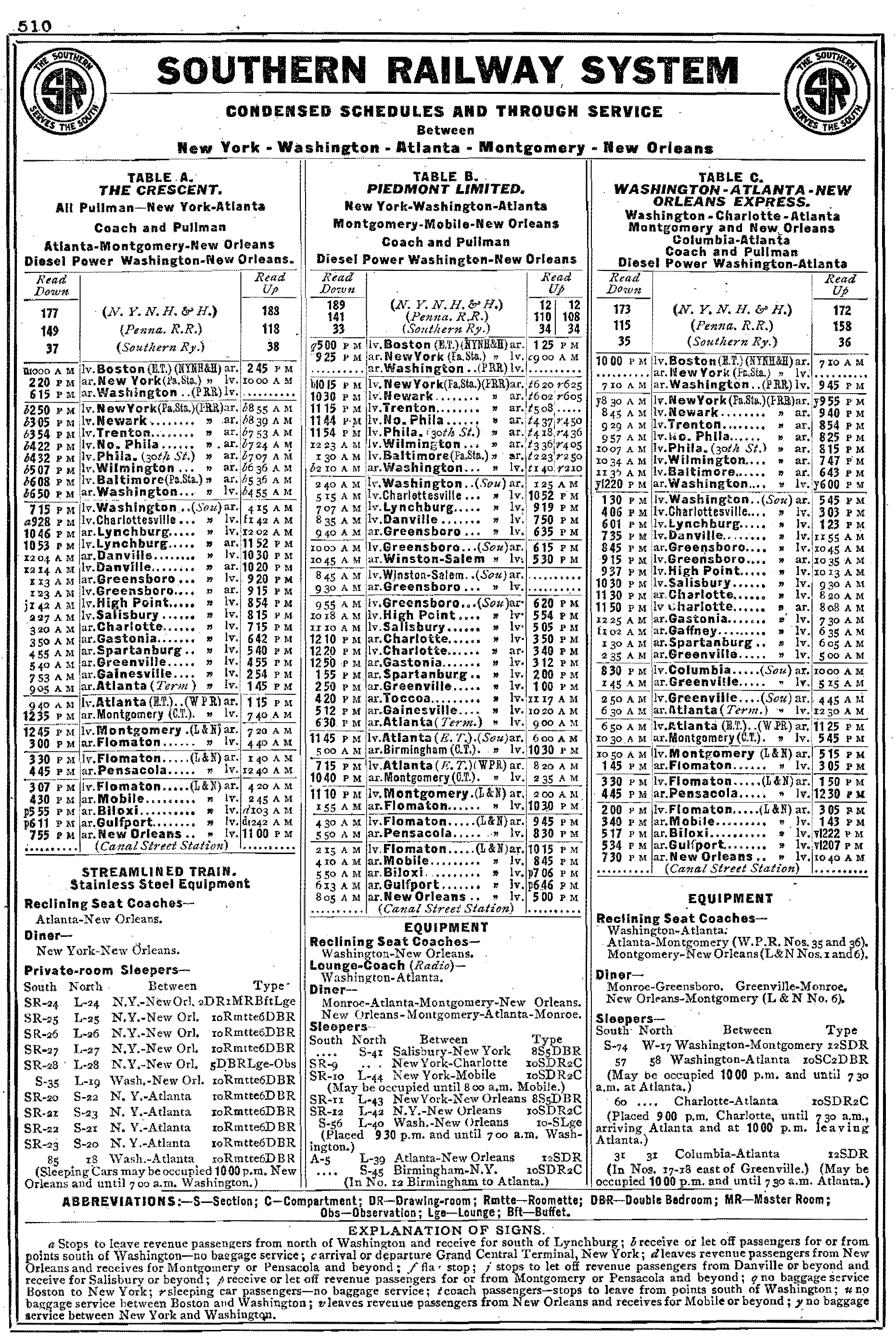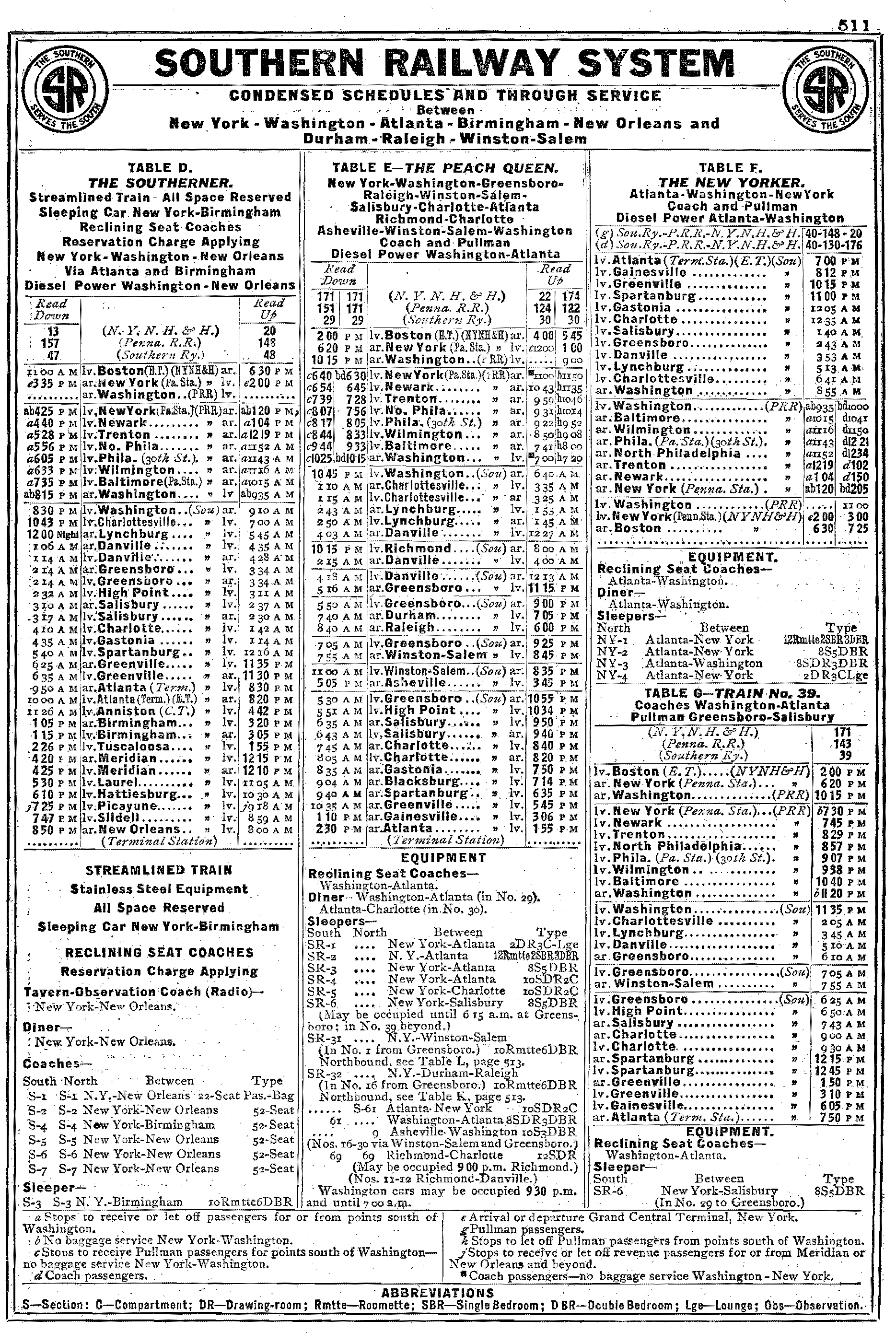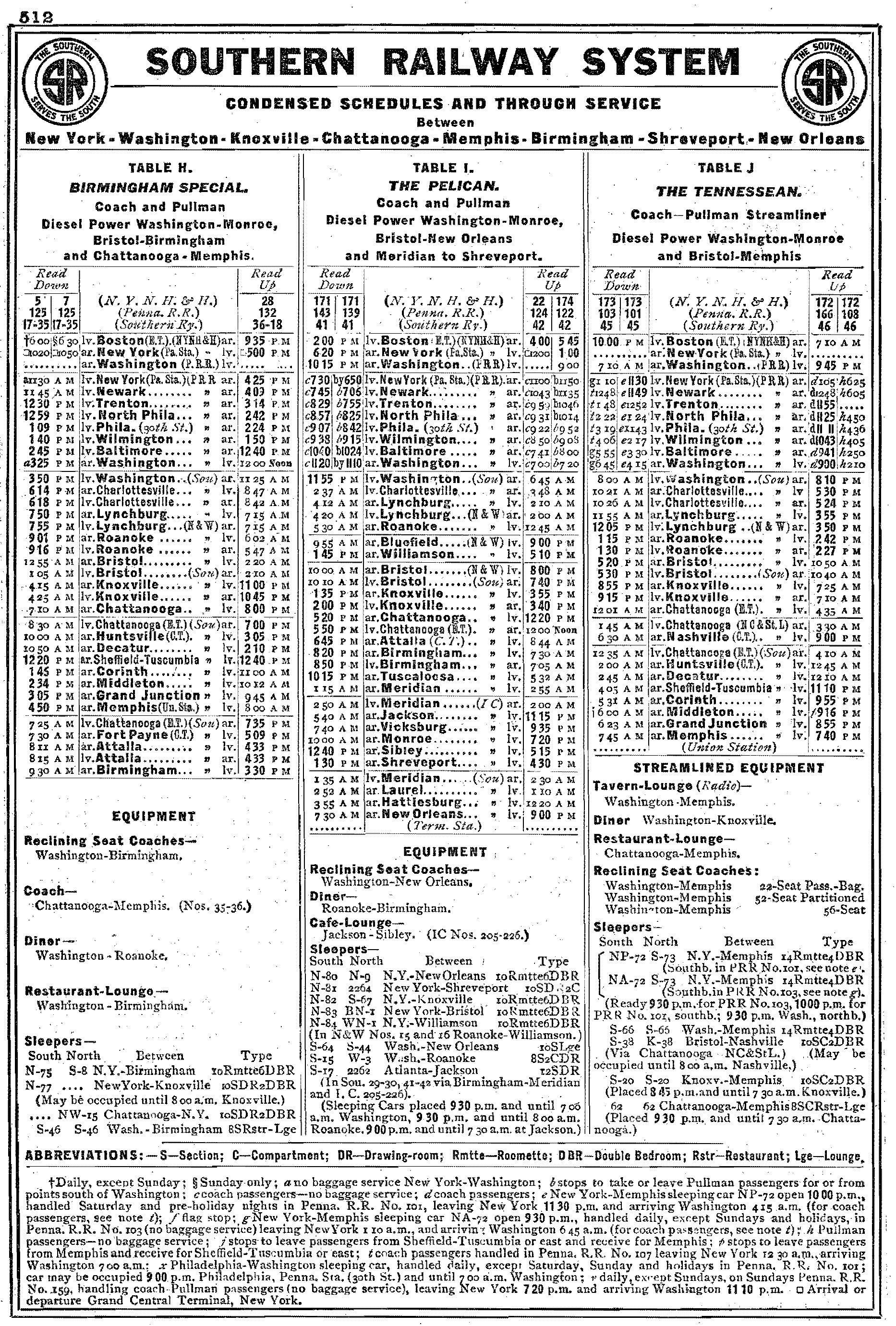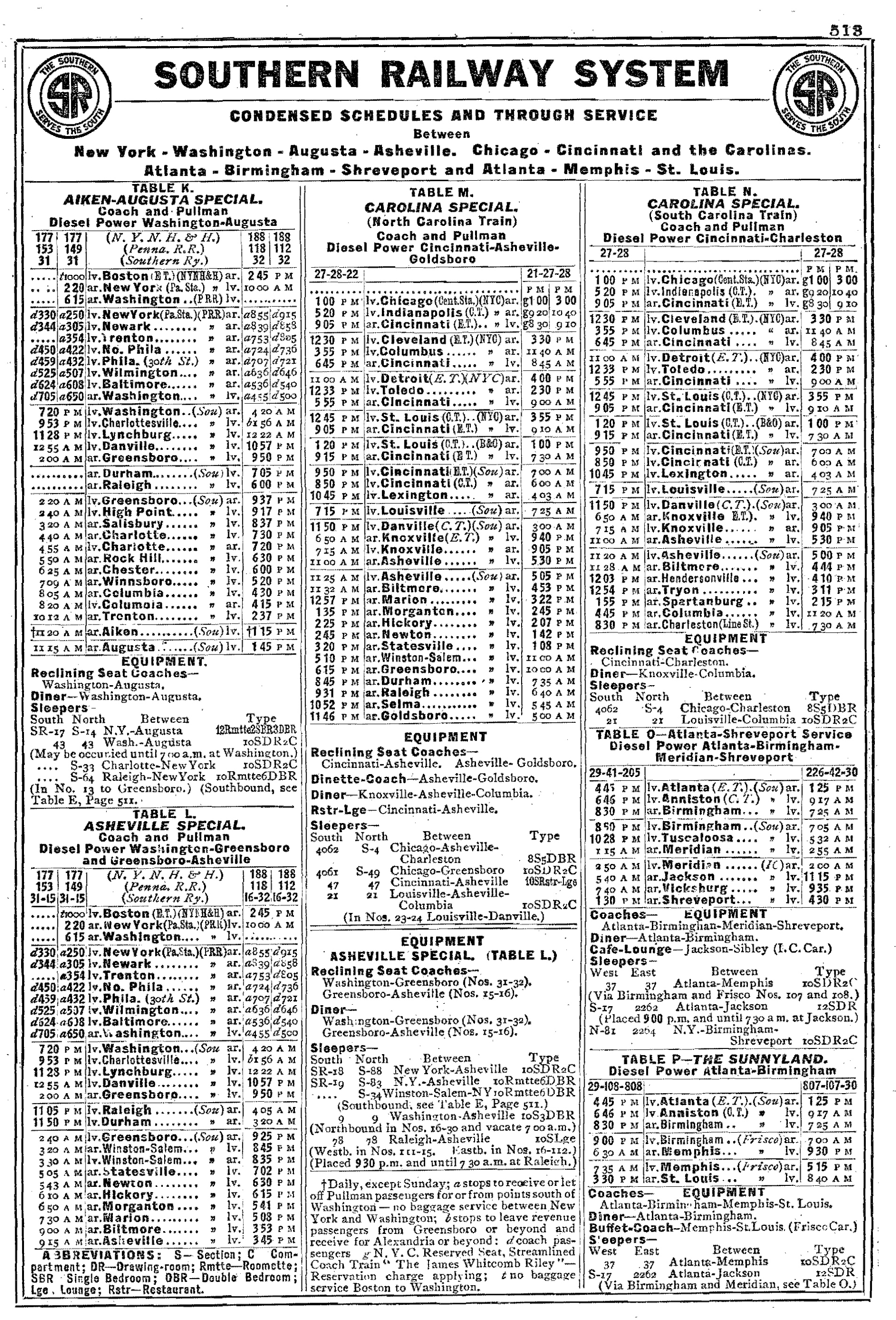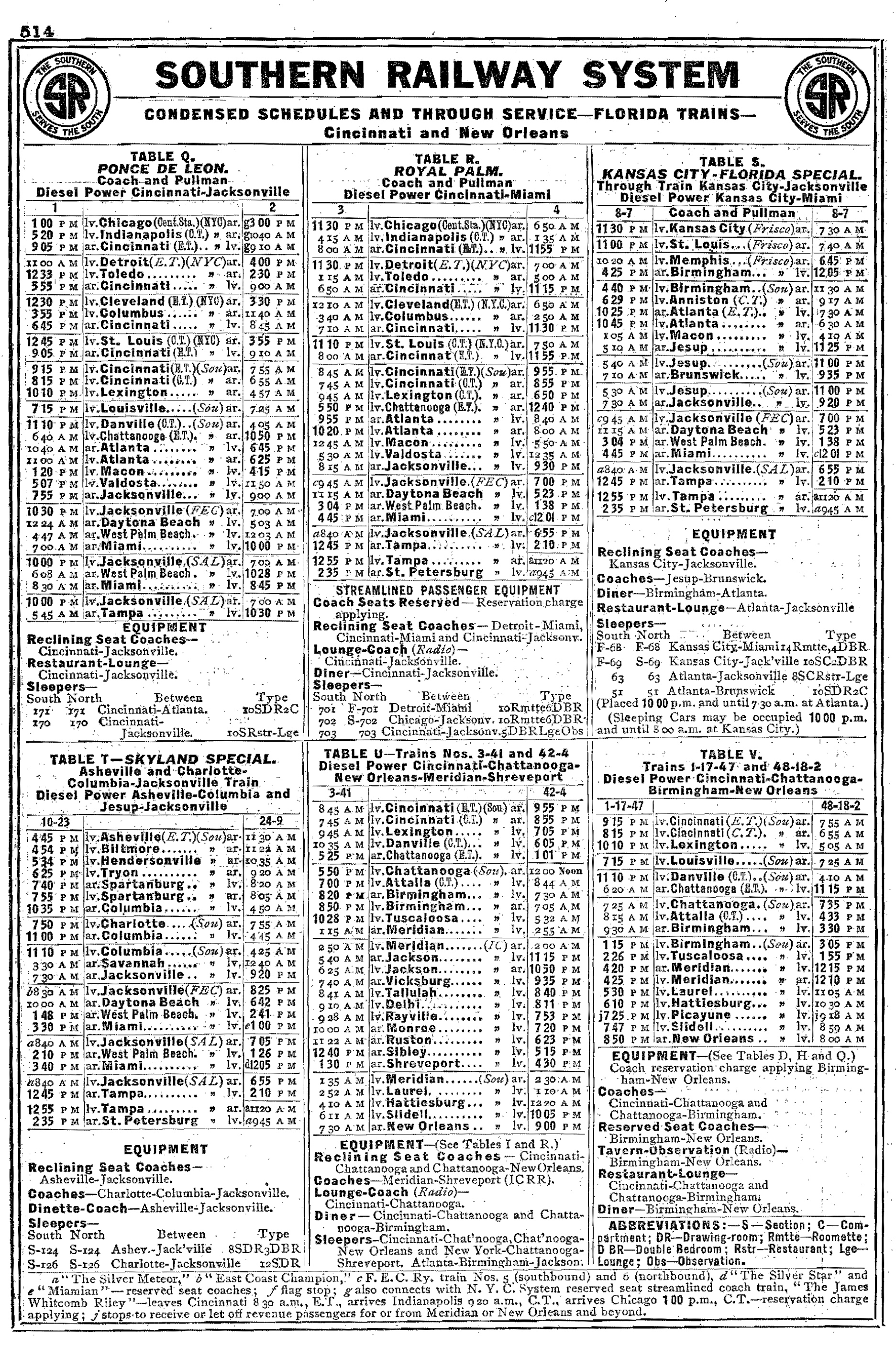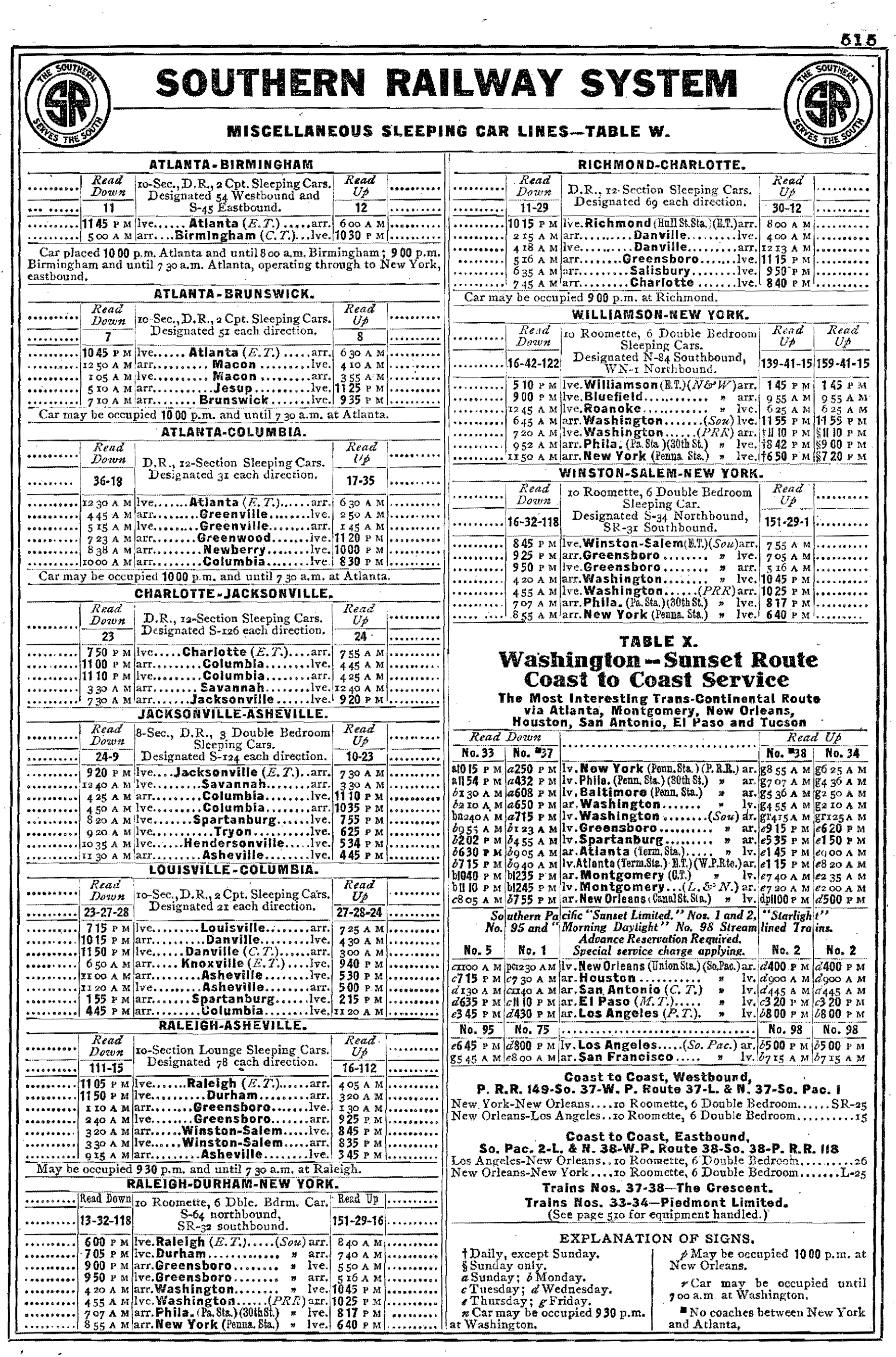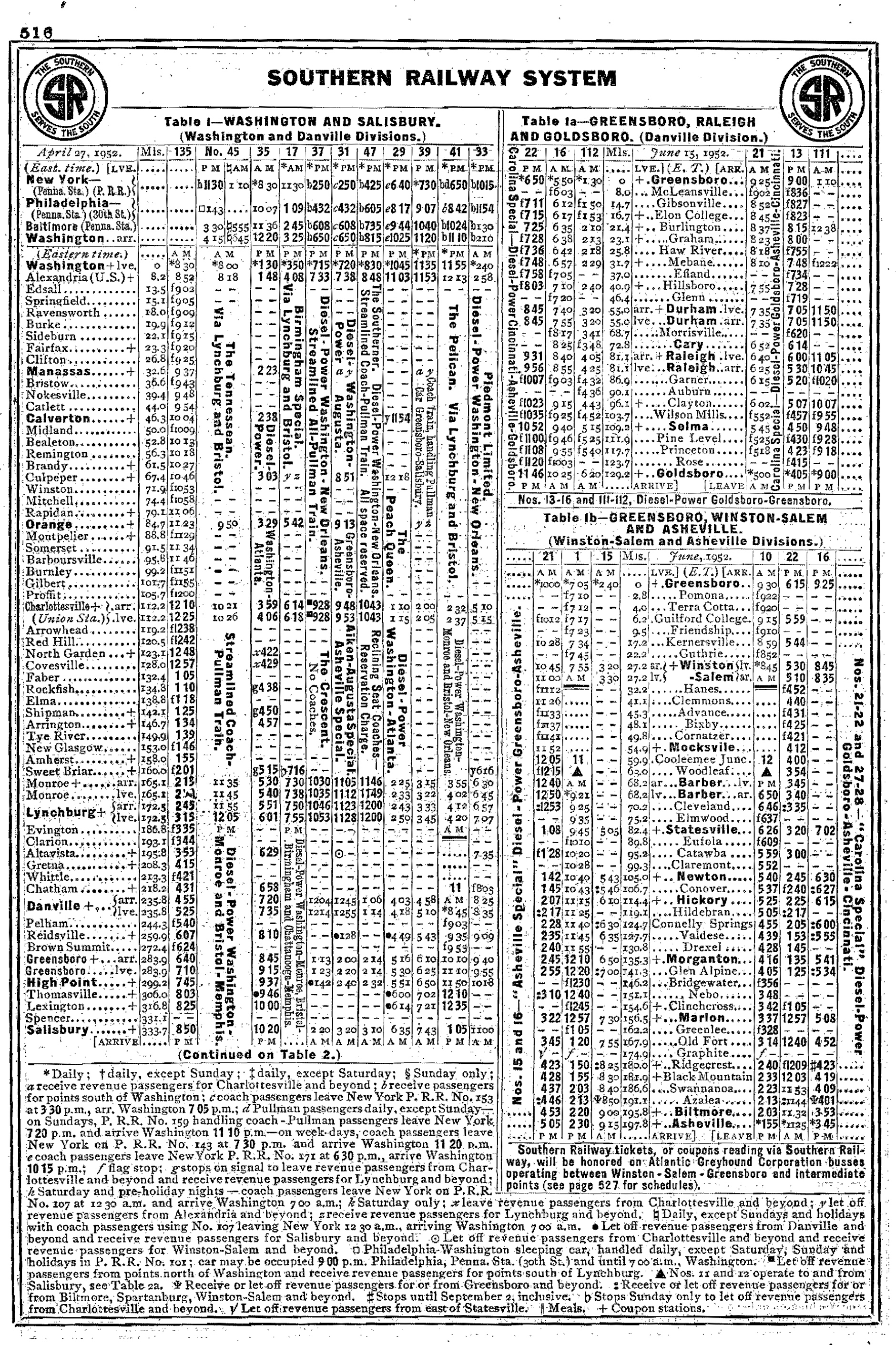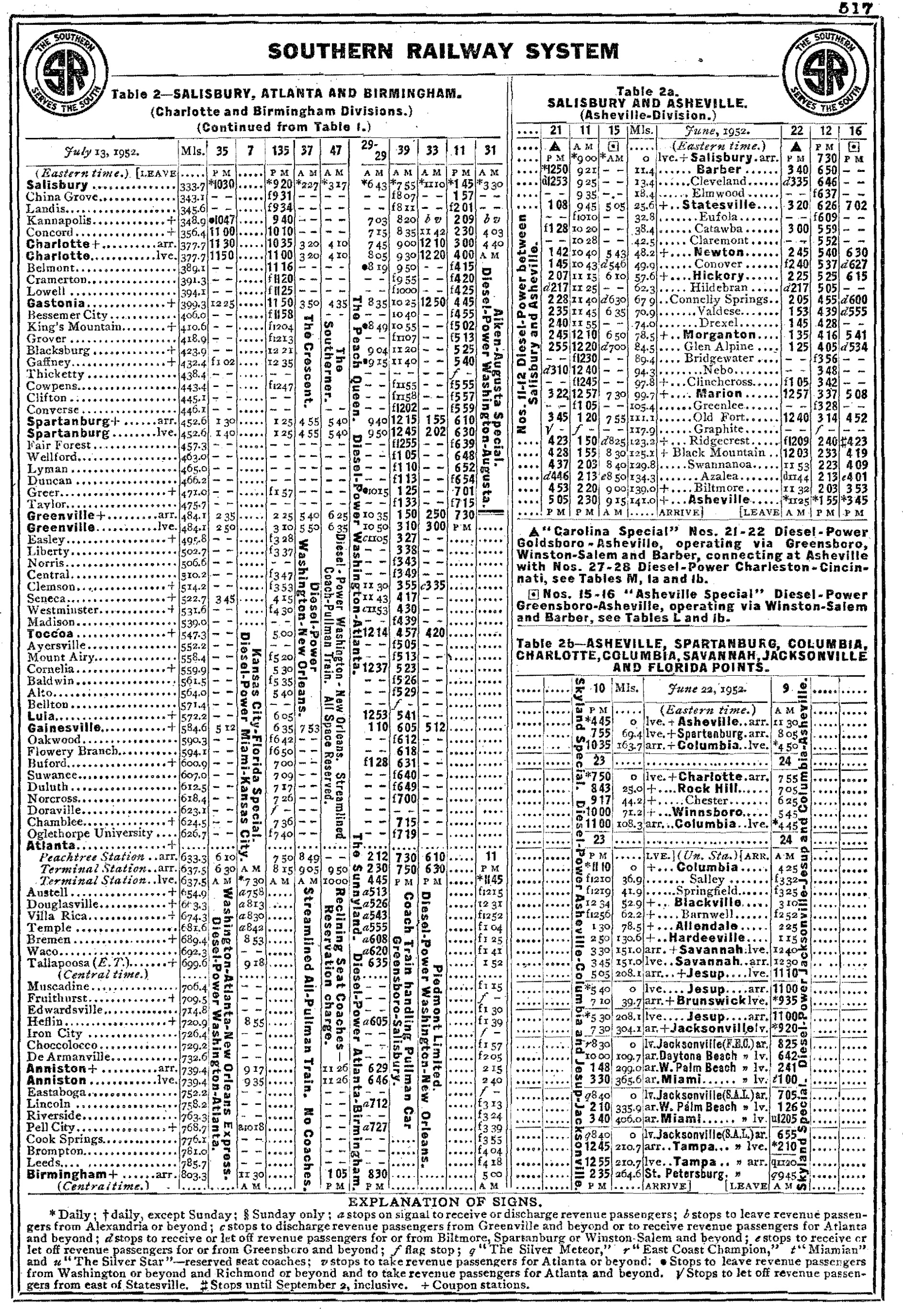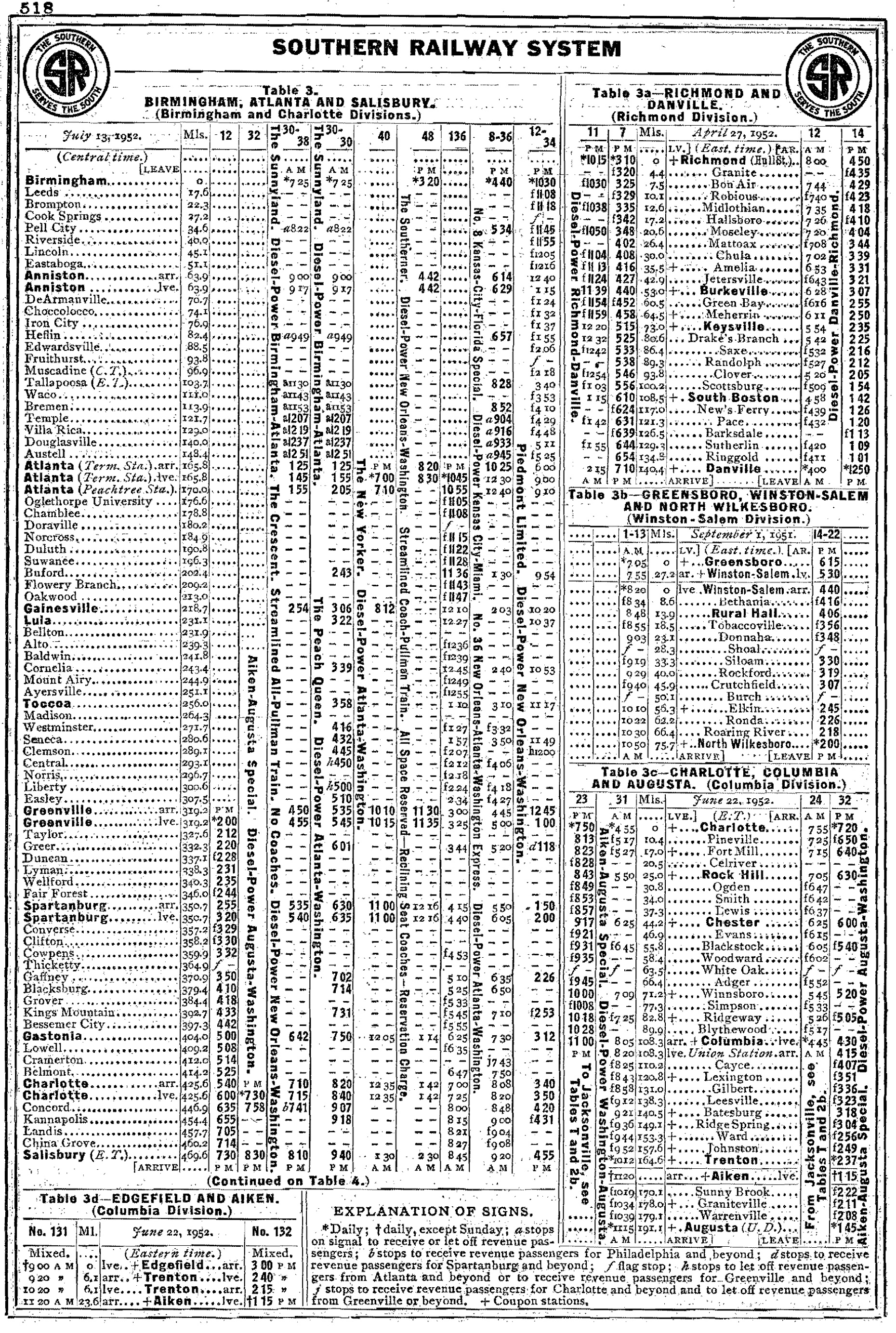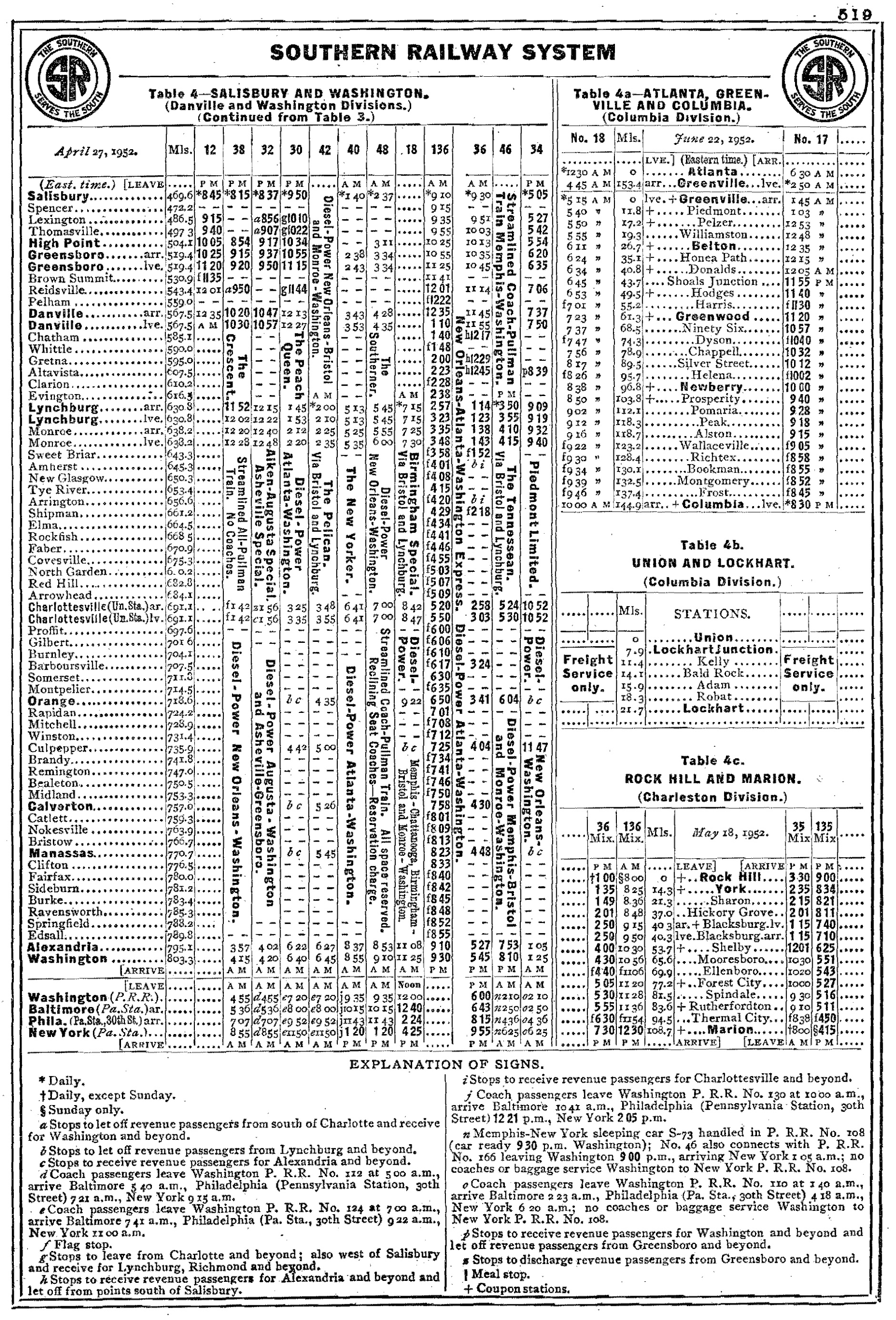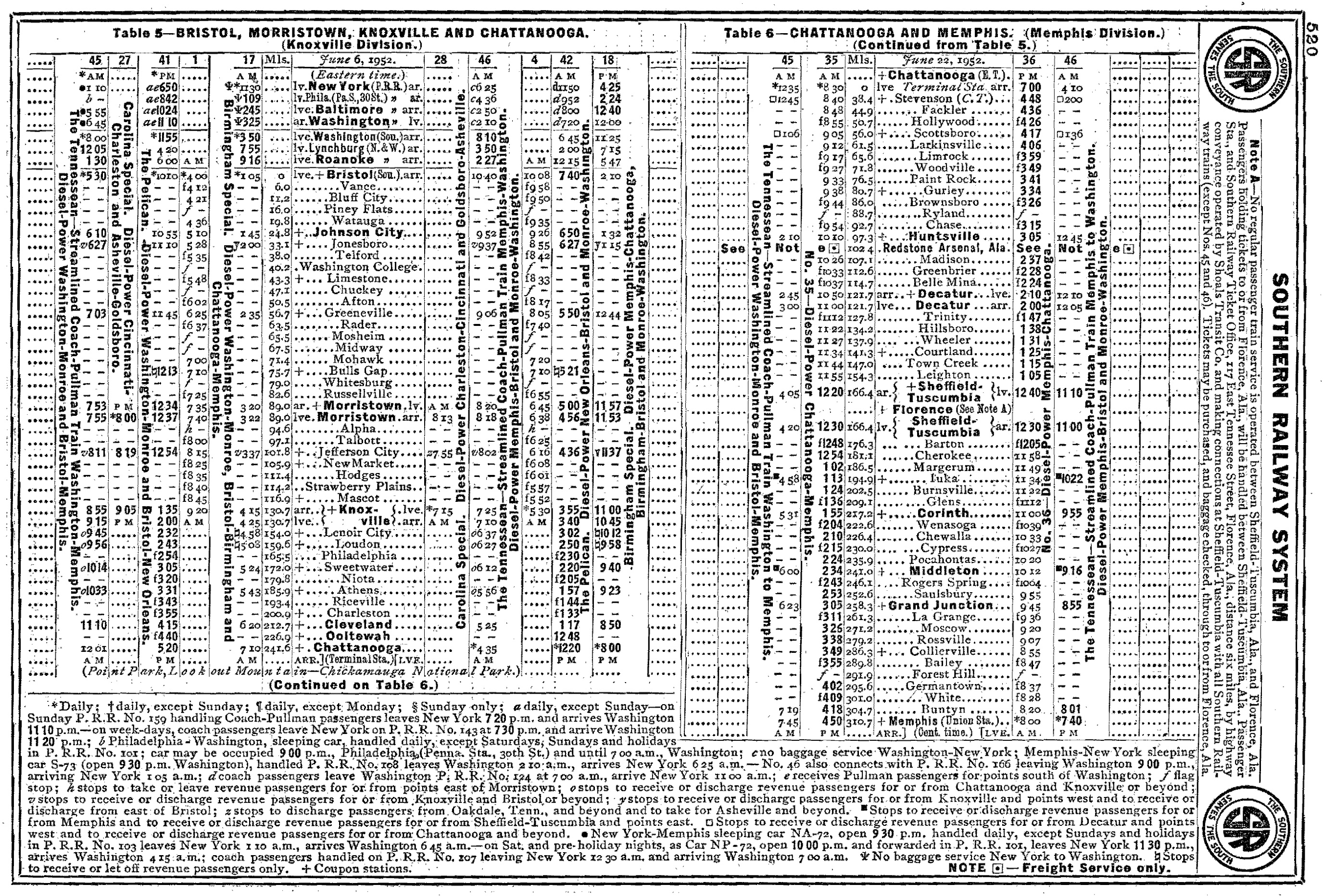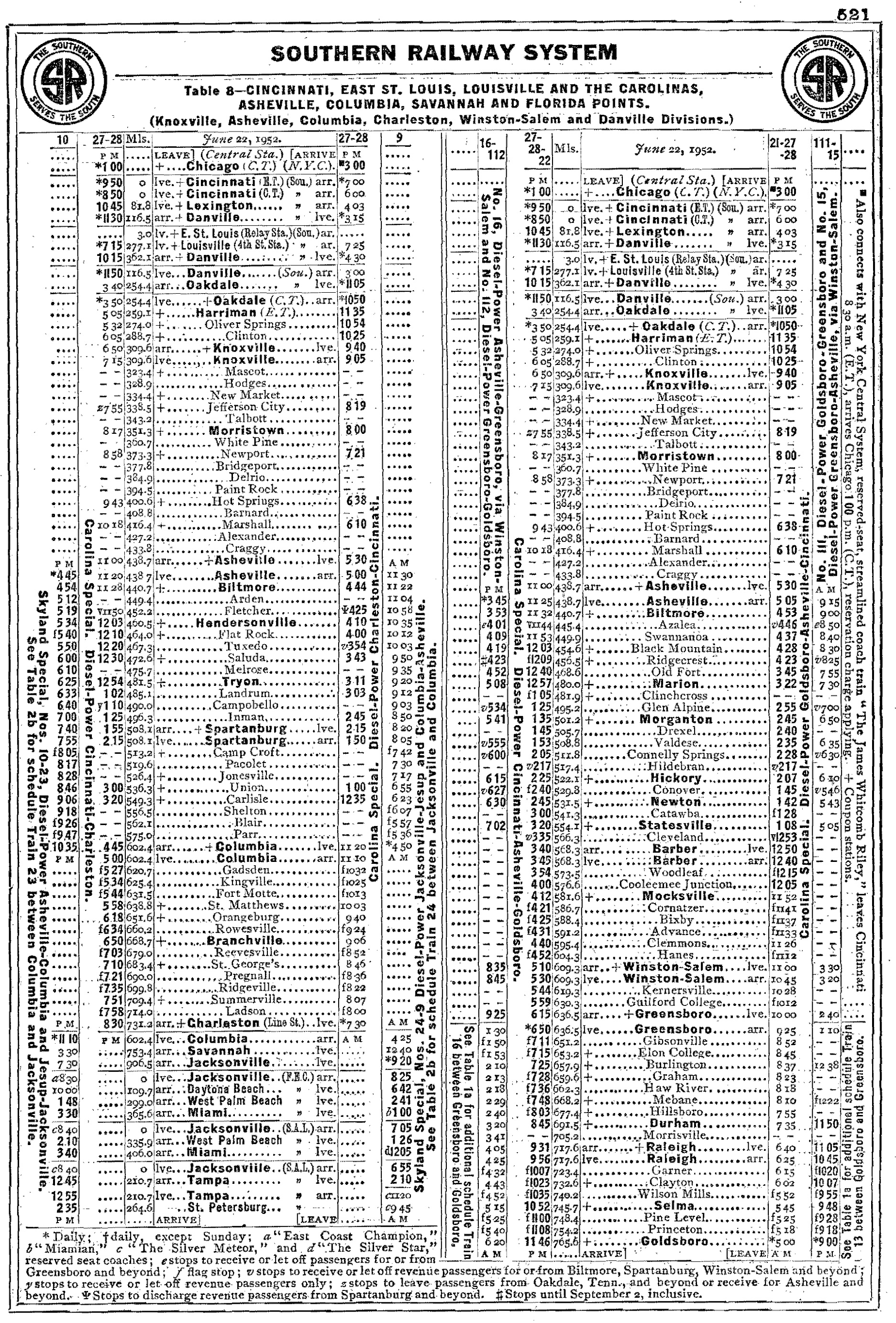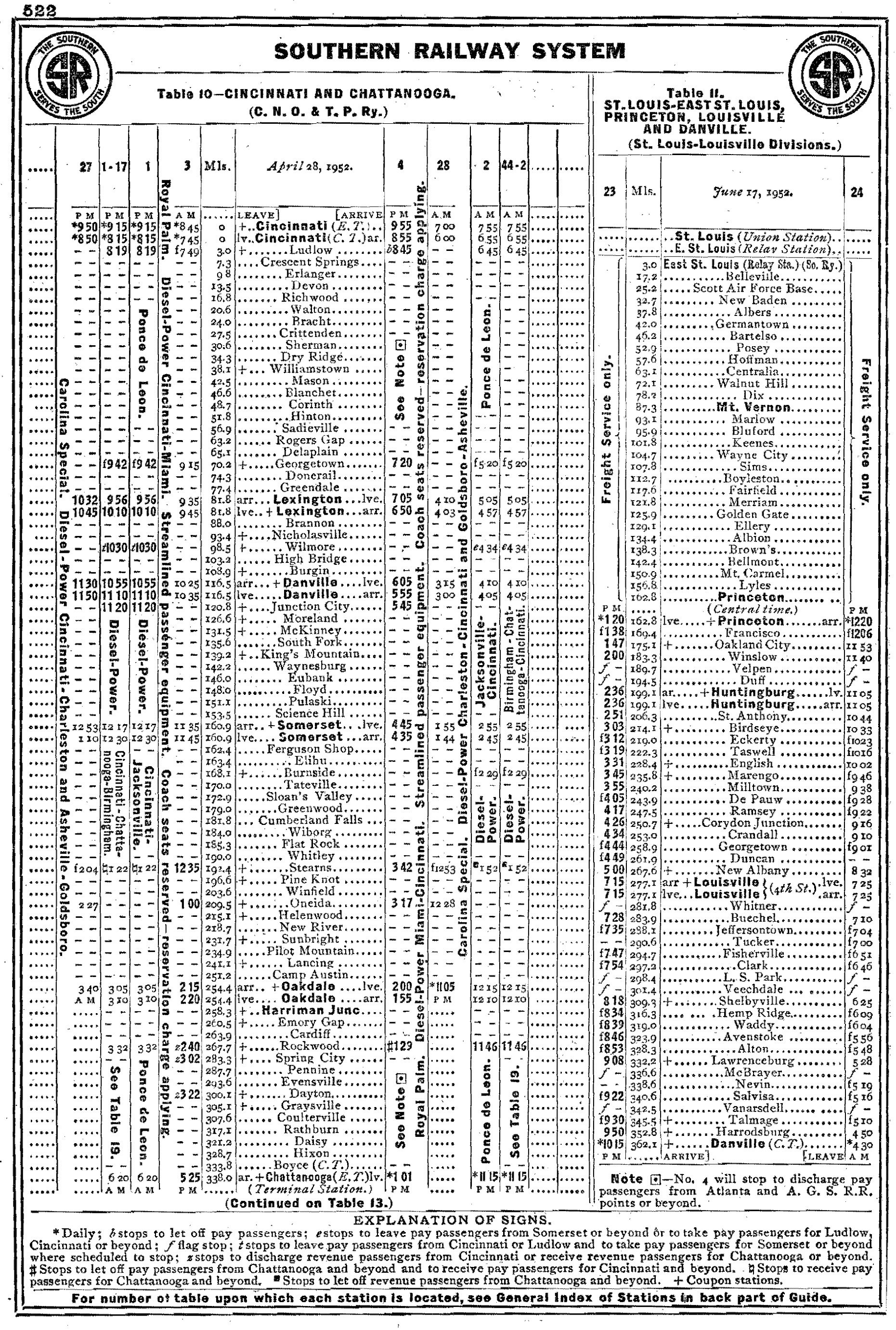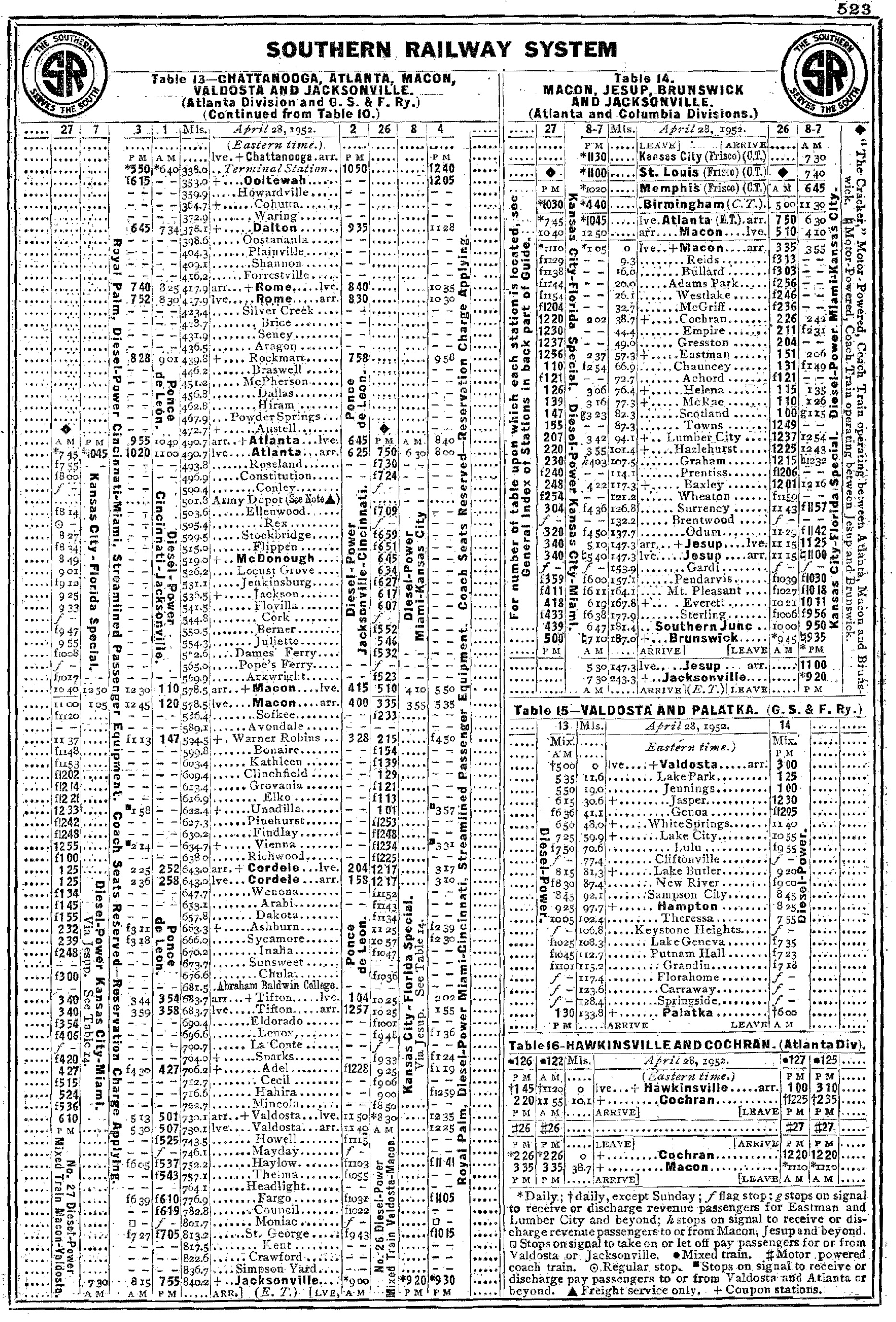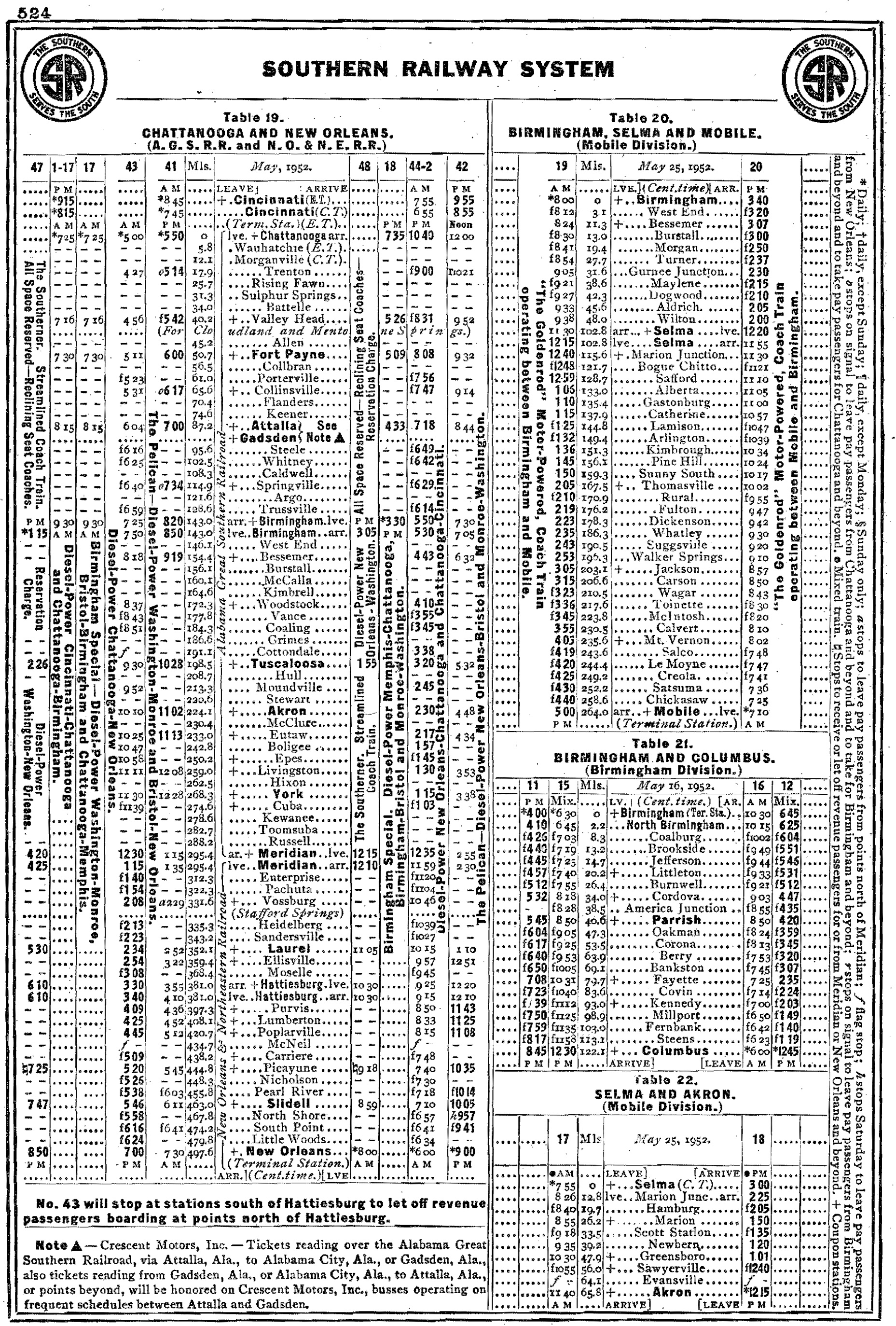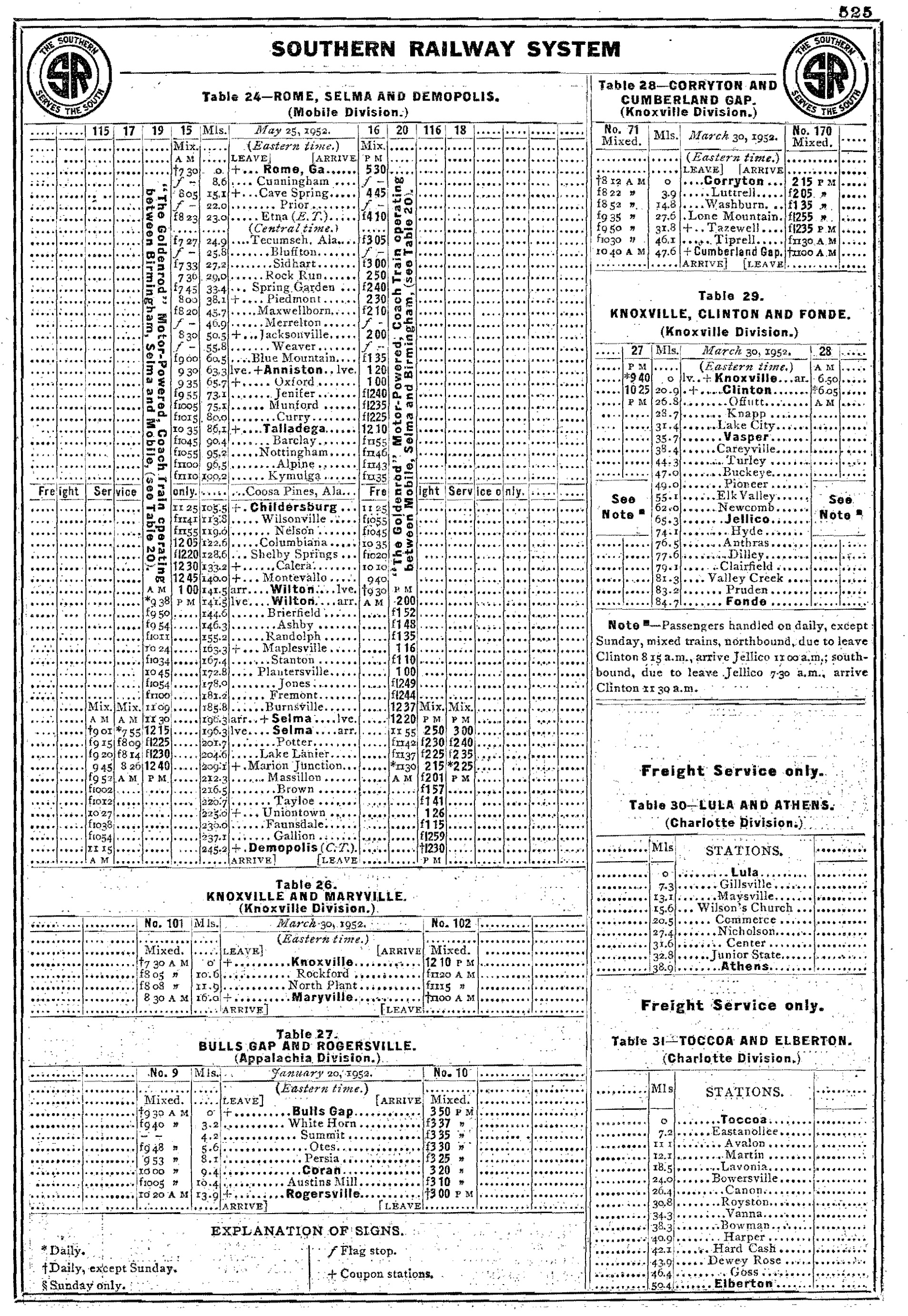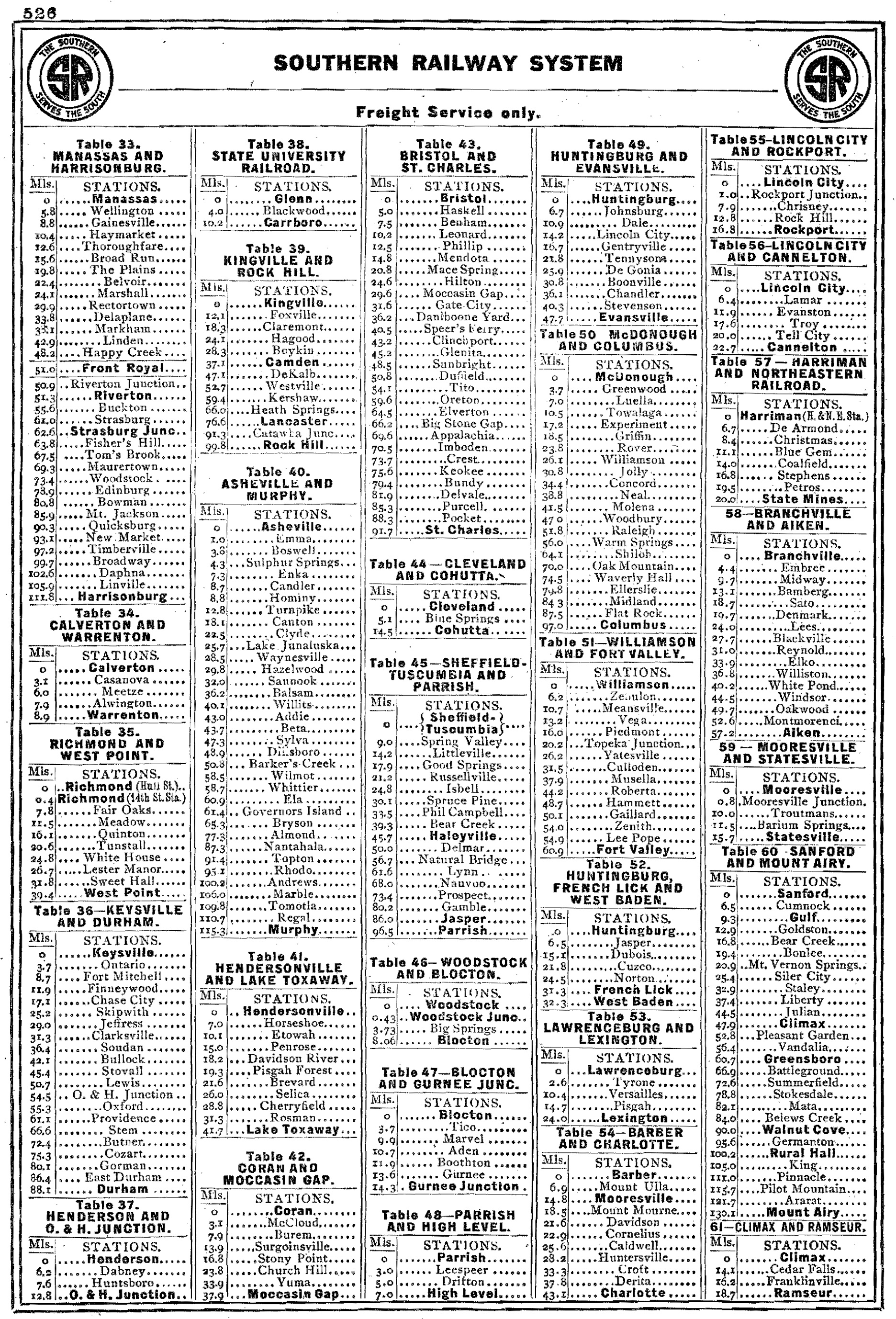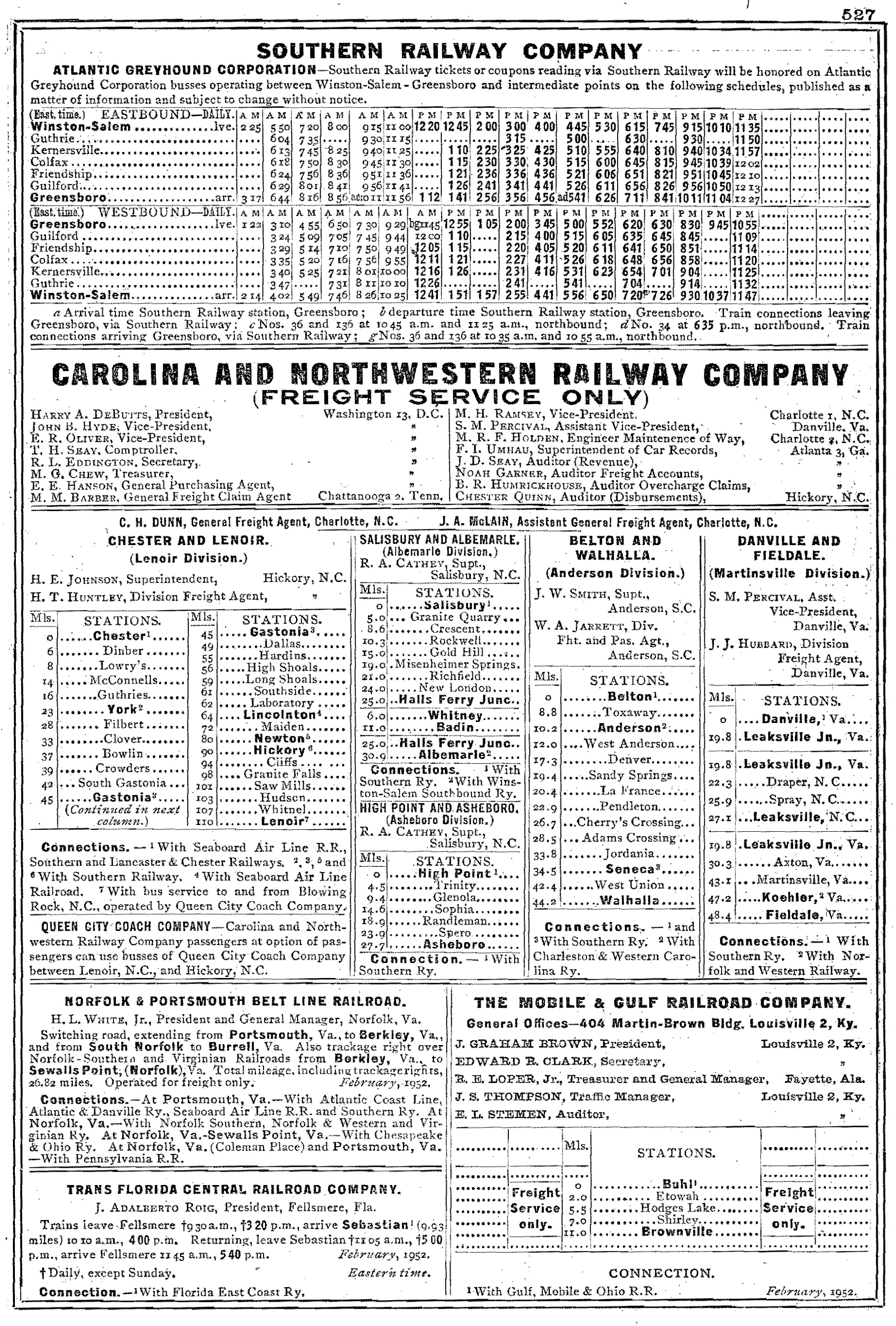Southern Railway (USA): Map, Locomotives, Logo, History
Last revised: February 22, 2025
By: Adam Burns
One of America's great transportation companies was the Southern Railway. Its immediate predecessor was the Richmond & Danville while a myriad of other systems came together in comprising a network of more than 6,000 route miles.
From an early period, excellent management defined the Southern. So well in fact that legendary railroader Jim McClellan is quoted as saying the company was a rather boring place to work (from Rush Loving, Jr.'s book, "The Men Who Loved Trains").
As a longtime officer who later worked at Norfolk Southern, McClellan knew of what he spoke. The Southern was a well-oiled machine with precision-like efficiency. Outwardly, it lived up to its name quite well as the South's largest railroad serving virtually every state below the Mason-Dixon Line and east of the Mississippi River.
Perhaps its classic Virginia Green livery was quite befitting for such a profitable and highly respected company. When CSX was formed in 1980 Southern and Norfolk & Western realized they must merge to remain competitive, completing the union in 1982. Today, much of the Southern remains an important component under Norfolk Southern.
Photos
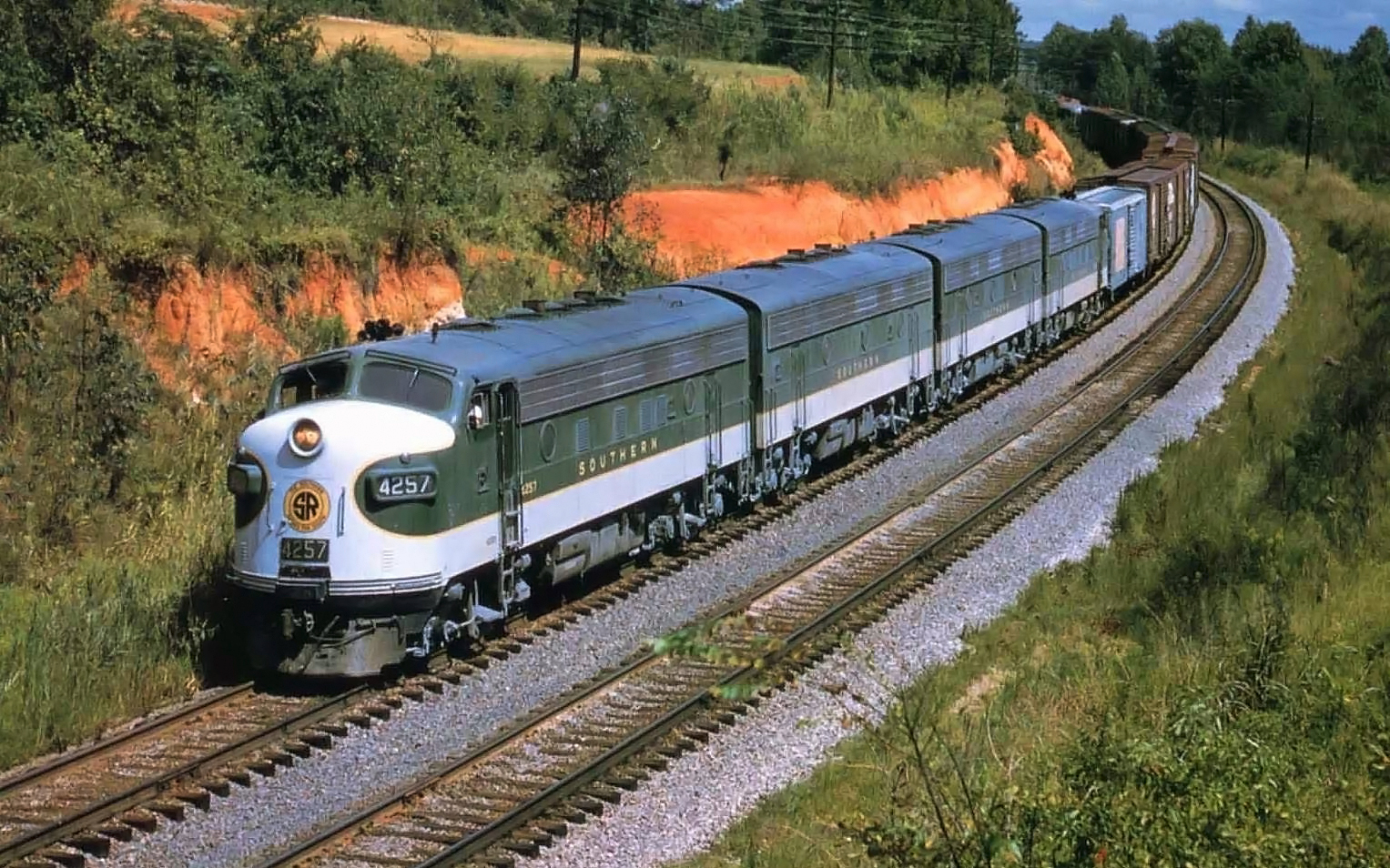 A classic set of Southern Railway F7's have through freight #154 rolling northbound near Austell, Georgia (just west of Atlanta) on May 26, 1956. Shelby Lowe photo.
A classic set of Southern Railway F7's have through freight #154 rolling northbound near Austell, Georgia (just west of Atlanta) on May 26, 1956. Shelby Lowe photo.History
The Southern Railway can trace its heritage all of the way back to the South Carolina Canal And Rail Road Company chartered on December 19, 1827. Its promoters envisioned the system to haul agricultural products from inland farms to the port city of Charleston.
The first 6 miles were in service during the summer of 1830 and by October of 1833 the entire 136-mile line was opened from Charleston to Hamburg (directly across the Savannah River from Augusta).
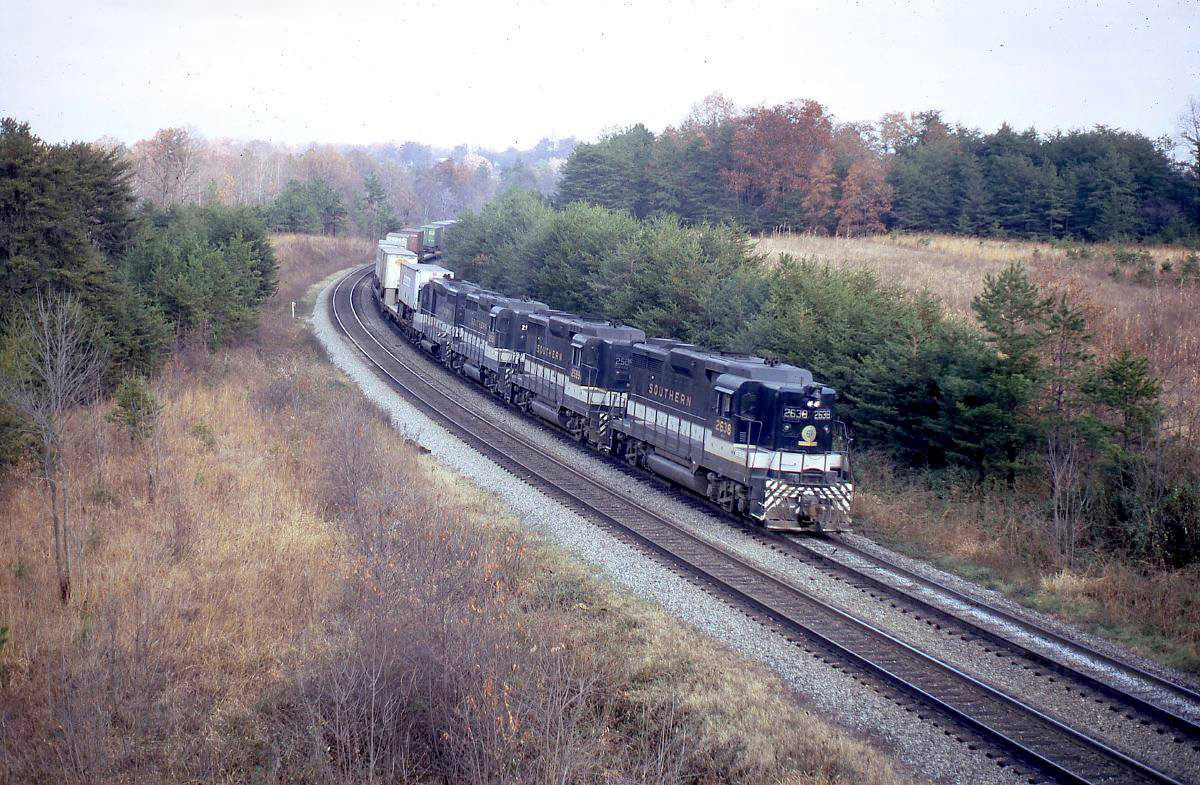 A quartet of Southern GP30's hustle a string of trailers along the main line near Greensboro, North Carolina during November of 1971. Warren Calloway photo.
A quartet of Southern GP30's hustle a string of trailers along the main line near Greensboro, North Carolina during November of 1971. Warren Calloway photo.At A Glance
5 Feet (1856 - 1886) 4 Feet, 8 ½ Inches (1886 - 1982) Washington, D.C. - Charlotte, North Carolina - Atlanta - Birmingham, Alabama - New Orleans Cincinnati, Ohio - Chattanooga, Tennessee - Birmingham Danville, Kentucky - St. Louis Chattanooga - Memphis Chattanooga - Morristown - Knoxville - Bristol, Tennessee Chattanooga - Atlanta - Valdosta, Georgia - Jacksonville, Florida Valdosta - Palatka, Florida Salisbury, North Carolina - Asheville - Morristown, Tennessee Asheville - Spartanburg, South Carolina - Charleston Charlotte - Jacksonville Danville, Virginia - Richmond - West Point, Virginia Greensboro, North Carolina - Norfolk, Virginia Rome, Georgia - Mobile, Alabama Selma - Morehead City, North Carolina Asheville - Murphy, North Carolina Knoxville, Tennessee - Cumberland Gap, Tennessee - Middlesboro, Kentucky Knoxville - Vasper, Tennessee - Fonde, Kentucky Manassas - Harrisonburg, Virginia Freight Cars: 40,038 Passenger Cars: 587 |
It was the longest railroad of its day although the Southern did not gain control of what was then the South Carolina & Georgia Railroad until 1899 which became part of its Piedmont Division.
The modern Southern Railway began with the Richmond & Danville Railroad chartered on March 9, 1847 to connect its namesake cities in Virginia.
The South at this time was developing into an economic juggernaut in the areas of cotton, agriculture, and manufacturing. The R&D completed its charter by 1856 on a 5-foot, broad-gauge network. It was not long before its promoters eyed further expansion.
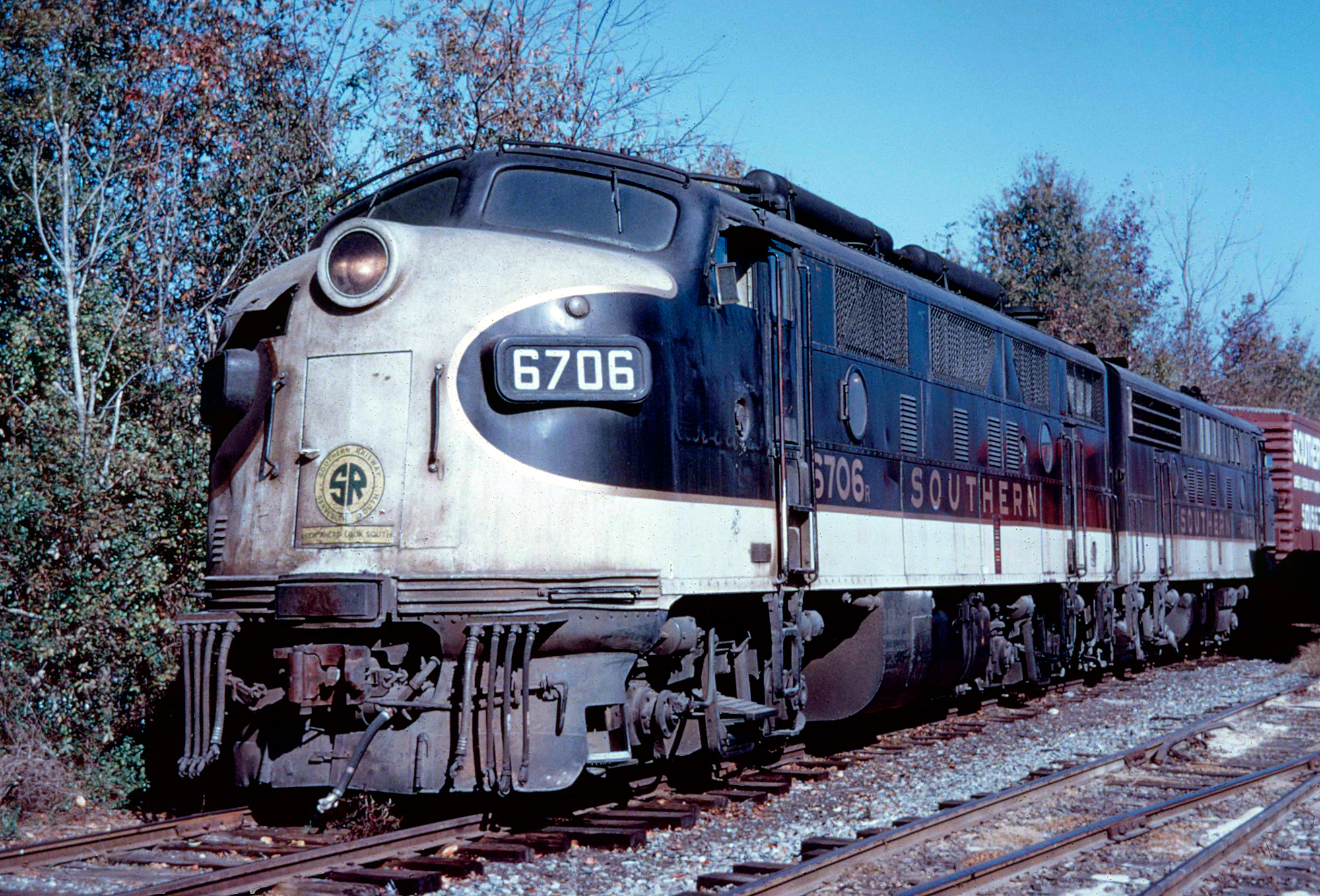 A pair of Southern Railway "F's" in service, led by F3A #6706, at Eatonton, Georgia; November 24, 1972. American-Rails.com collection.
A pair of Southern Railway "F's" in service, led by F3A #6706, at Eatonton, Georgia; November 24, 1972. American-Rails.com collection.Formation
There is a long, seemingly infinite list of predecessors which comprised the modern Southern Railway. Three which stand out include the Richmond & Danville; East Tennessee, Virginia & Georgia; and Queen & Crescent Route.
For many builders, acquiring the necessary funding coupled with the political backing and general fortitude in seeing a railroad completed was extremely difficult. Many grand projects never made it off the paper they were written on while others ran out of money before completion.
The Richmond & Danville was one of the few to have success relatively early and continued rapid expansion thereafter. Despite the ongoing Civil War it reached Greensboro, North Carolina in 1864 through a subsidiary known as the Piedmont Railroad.
By 1873 Atlanta was reached along with a connection to Washington, D.C. through a partnership with several other carriers that marketed their route as the "Piedmont Air-Line."
This term had nothing to do with air planes or flying; it became popular at the time to describe what was at least perceived as a high-speed, low-grade corridor envisioned with high fills, deep cuts, and towering bridges.
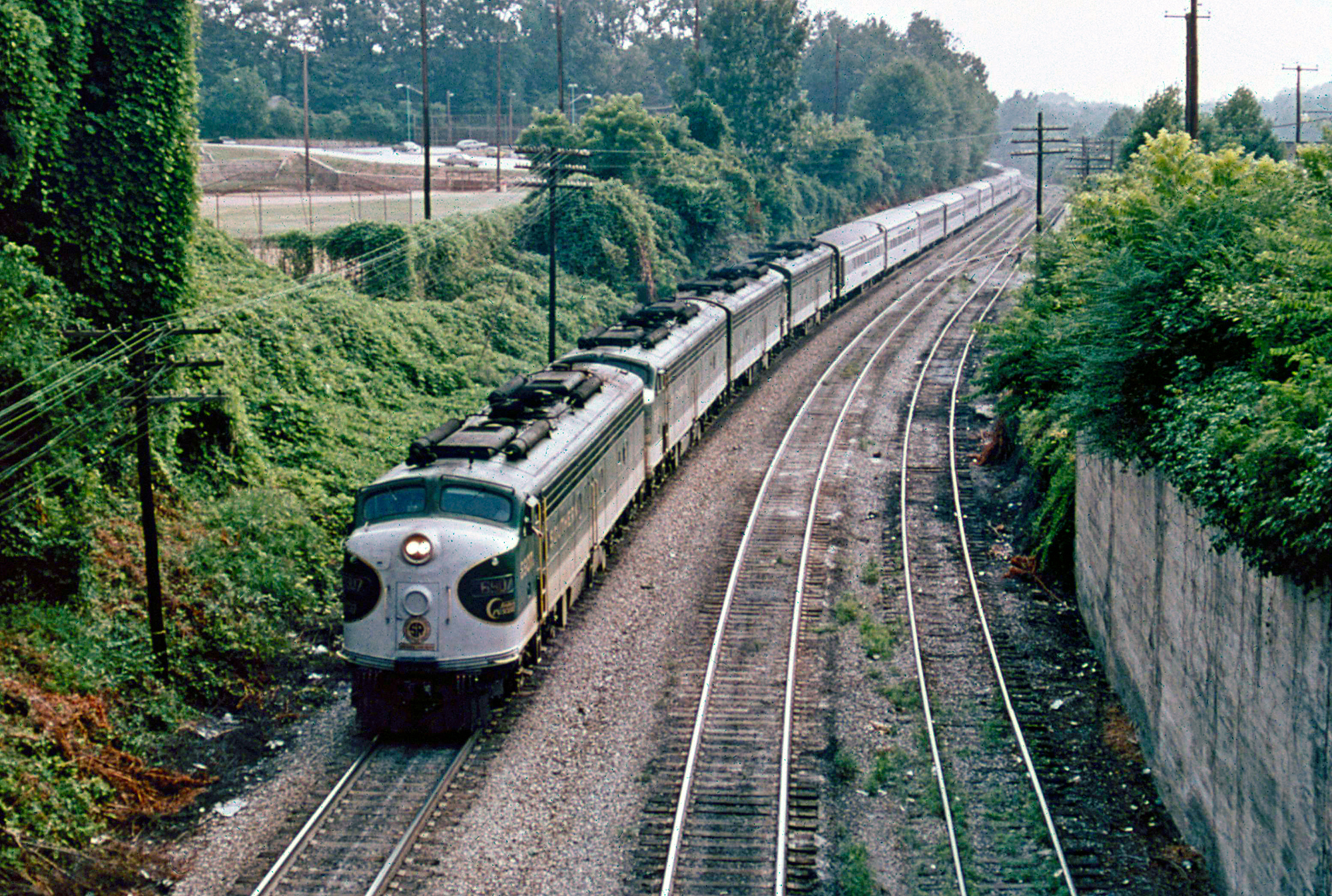 A quartet of Southern Railway E8A's, led by #6907, have the "Southern Crescent" at Atlanta, Georgia on July 11, 1978. Carl Sturner photo. American-Rails.com collection.
A quartet of Southern Railway E8A's, led by #6907, have the "Southern Crescent" at Atlanta, Georgia on July 11, 1978. Carl Sturner photo. American-Rails.com collection.These railroads, which included the Atlanta & Richmond Air Line (Charlotte - Atlanta); North Carolina Railroad (Charlotte - Morehead City, it is still owned by the state); Charlotte, Columbia & Augusta (Charlotte, North Carolina to Augusta, Georgia); and Richmond & York River (Richmond to West Point, Virginia) all would eventually fall under the Richmond & Danville's control.
Through a series of corporate maneuverings, R&D ownership formed the Richmond Terminal in 1880 to continue expansion across the south. According to Tom Murray's book, "Southern Railway," within just a few years the two companies controlled some 2,500 miles of track!
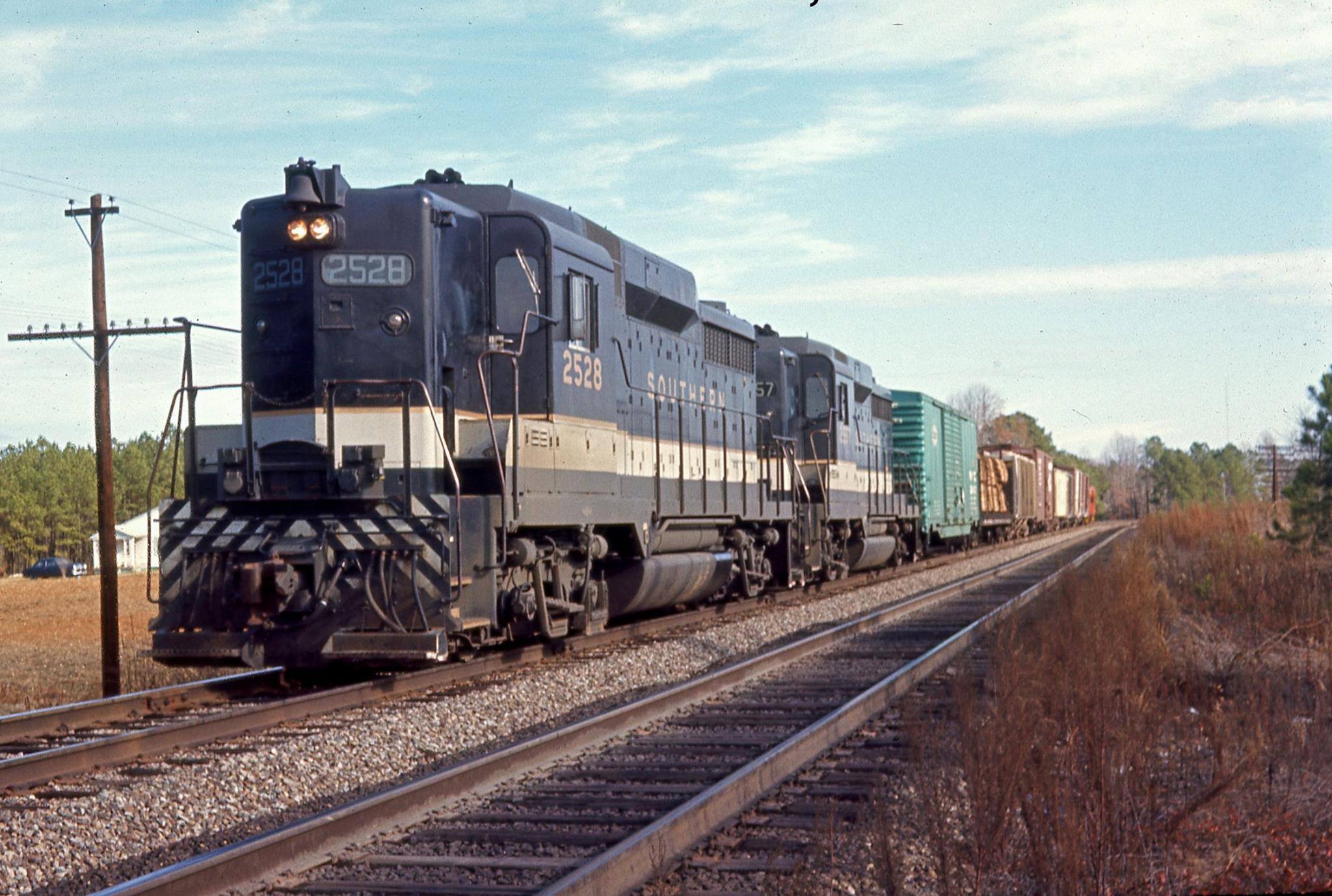 Southern GP30's working local service at Cary, North Carolina in the fall of 1965. Warren Calloway photo.
Southern GP30's working local service at Cary, North Carolina in the fall of 1965. Warren Calloway photo.Expansion
The next important component was the East Tennessee, Virginia & Georgia Railway. In time it became nearly as large as the R&D. Its story begins with two predecessors; the East Tennessee & Virginia and East Tennessee & Georgia.
The former was incorporated on January 27, 1848 and opened a 131-mile route from Knoxville to Bristol, Tennessee in 1856.
The latter initially began as the Hiwassee Rail Road incorporated on February 19, 1836 and then reorganized as the East Tennessee & Georgia on January 1, 1847. It completed a 140-mile line from Knoxville, Tennessee to Dalton, Georgia via Chattanooga in 1859.
Logo
In the following decade the two merged in 1869 to form the East Tennessee, Virginia & Georgia Railway. At first, the ETV&G was little more than a regional system.
However, soon a connection was established with the Virginia & Tennessee (a future Norfolk & Western component) in opening a through route to the port of Norfolk, Virginia.
In 1872 the ETV&G set out upon a massive expansion program by acquiring numerous smaller lines, starting with a lease of the 332-mile Memphis & Charleston linking Memphis with Stevenson, Alabama. Then, in 1880 the Selma, Rome & Dalton was added from Selma, Alabama to Kingston, Georgia.
A year later this was followed with the Macon & Brunswick, which ran 185 miles between its namesake cities. At first, the M&B was disconnected from the ETV&G's network.
However, in short order a new extension was finished from Rome to Macon, which provided a through route to the Atlantic coast. At its peak the ETV&G owned or controlled some 1,400 miles. Ownership at the time, hoping to further line their pockets, sold out to the Richmond & Danville in February of 1887.
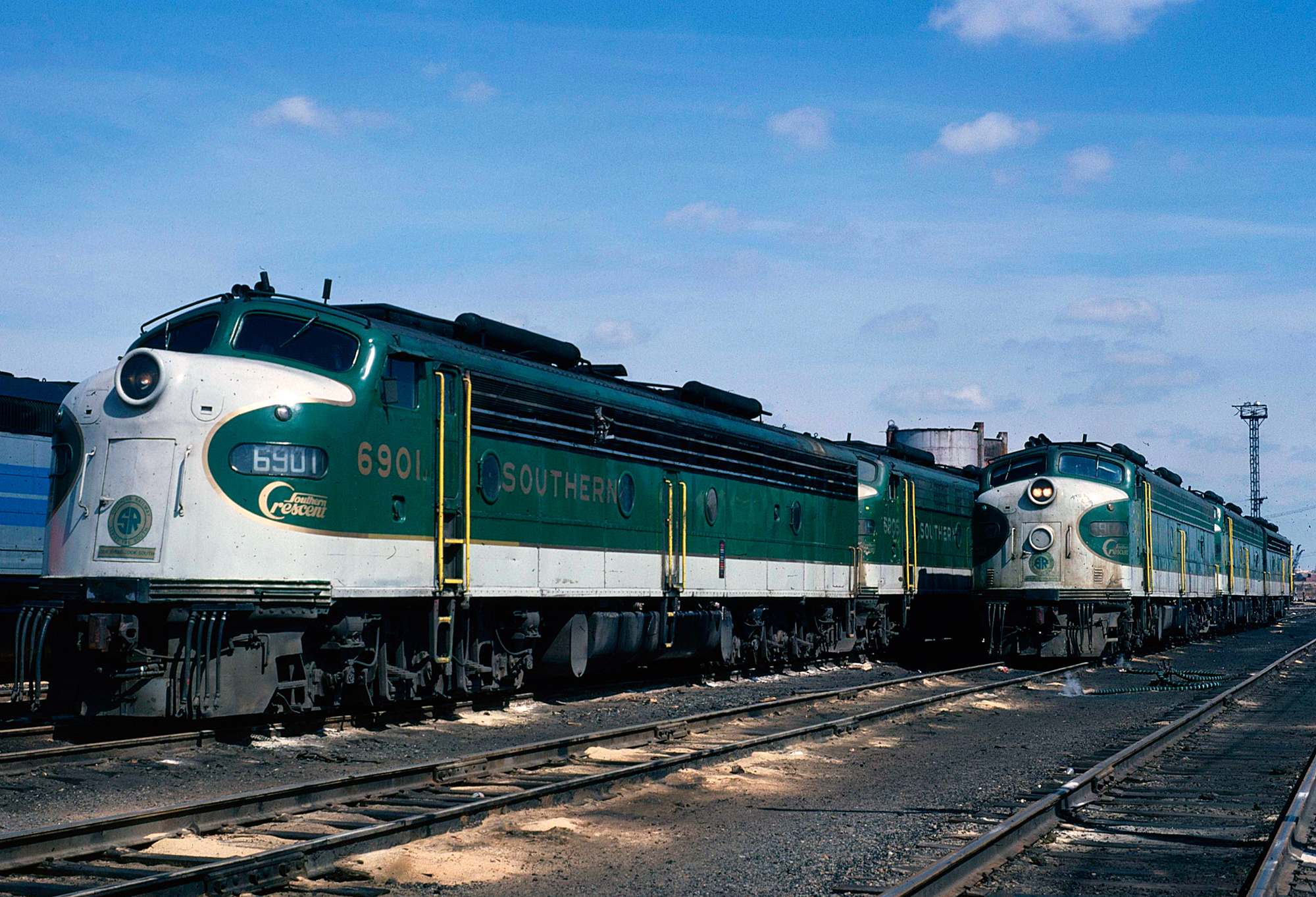 A handsome group of Southern Railway E8A's layover at the Ivy City engine terminal in Washington, D.C. awaiting their next assignments to lead the "Southern Crescent" on March 19, 1977. William Mischler photo. American-Rails.com collection.
A handsome group of Southern Railway E8A's layover at the Ivy City engine terminal in Washington, D.C. awaiting their next assignments to lead the "Southern Crescent" on March 19, 1977. William Mischler photo. American-Rails.com collection.Finally, there was the Queen & Crescent Route. This was not actually a railroad but rather a consortium of systems providing a through route from Cincinnati, Ohio to New Orleans. Three of note went on to join the future Southern Railway.
These included the Cincinnati, New Orleans & Texas Pacific (created in 1881 it ran 336 miles along a twisting and winding main line from Cincinnati to Chattanooga); Alabama Great Southern (formed in November of 1877 it completed a 295-mile corridor from Chattanooga to Meridian, Mississippi); and the New Orleans & Northeastern (incorporated in 1868 it opened a 196-mile route from Meridian to New Orleans in 1883).
System Map (1952)
The CNO&TP is of particular interest; later known as Southern's "Rathole Division" due to numerous tunnels until an improvement program in the 1960's eliminated many, the line was originally built by Cincinnati's own Cincinnati Southern Railway.
The CNO&TP leased it from the city in 1881 which passed on to the ETV&G in 1890. The Southern later continued the lease through the CNO&TP and today it carries on under Norfolk Southern. The Alabama Great Southern was also leased in 1890 while the New Orleans & Northeastern was a late addition, not joining the Southern until 1916.
System Map (1969)
In 1890 the Richmond Terminal Company, which controlled or operated most of the above-mentioned properties, had a staggering network of nearly 9,000 route miles. According to Mike Schafer's book, "More Classic American Railroads," as early as 1887 the R&D and ETV&G were studying the possibility of merger.
Unfortunately, financial issues delayed the union and then the Richmond Terminal failed. Banking mogul J.P. Morgan subsequently gained control of the assets and believed the only means of successfully reorganizing the company was to unify a faction of its railroads under one system.
Thus was born the Southern Railway on July 1, 1894. Morgan, who only oversaw the company through reorganization, believed a healthy railroad was only possible utilizing less than half of the former network.
Totaling just over 2,000 route miles these included the Richmond & Danville, Virginia Midland (reaching Washington, D.C. via Danville), Piedmont Railroad, North Carolina Railroad (leased), and Atlanta & Charlotte Air Line.
Before long, under the direction of Samuel Spencer, most of the original trackage was reacquired. Later in the summer of 1894 the East Tennessee, Virginia & Georgia; Charlotte, Columbia & Augusta; Georgia Pacific; Louisville Southern; and Columbia & Greenville all rejoined the system. These railroads totaled some 2,400 route miles.
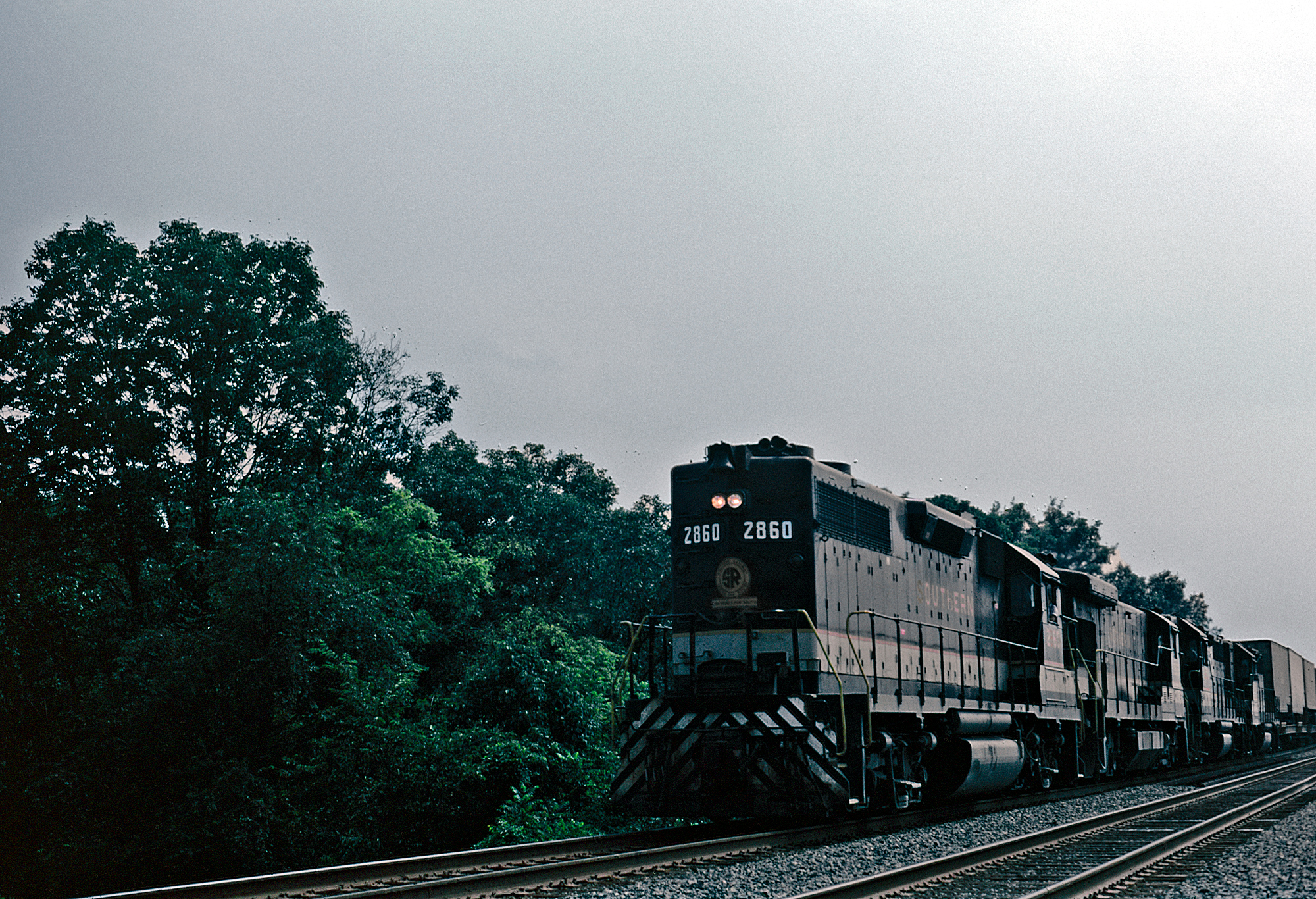 Southern GP38AC #2860 leads trailers southbound near Midland, Virginia in August, 1982. American-Rails.com collection.
Southern GP38AC #2860 leads trailers southbound near Midland, Virginia in August, 1982. American-Rails.com collection.At the end of the century more additions followed: in 1895 the Atlanta & Florida; Georgia Southern & Florida; and Alabama Great Southern all came under Southern control. Then, the Memphis & Charleston was added three years later.
Just before 1900 yet more followed including the South Carolina & Georgia; Augusta Southern; Mobile & Birmingham; Atlantic & Danville; and finally the Cincinnati, New Orleans & Texas Pacific. Altogether, Southern operated 6,431 route miles.
Running south from our nation's capital it connected the Carolina's, served much of Georgia and Alabama, and then terminated in northern Florida. The road's expansion continued into the early 20th century; in 1901 it reached the important gateway of St. Louis through the Louisville, Evansville & St. Louis.
A year later a link to Jacksonville, Florida was established via the Atlantic, Valdosta & Western. In 1908 it grabbed the Virginia & Southwestern which provided an important coal line into the state's southwestern corner.
Here, interchange commenced with the important coal roads of the Clinchfield, Interstate, and Louisville & Nashville. As previously mentioned, its last great extension occurred with the 1916 takeover of the New Orleans & Northeastern.
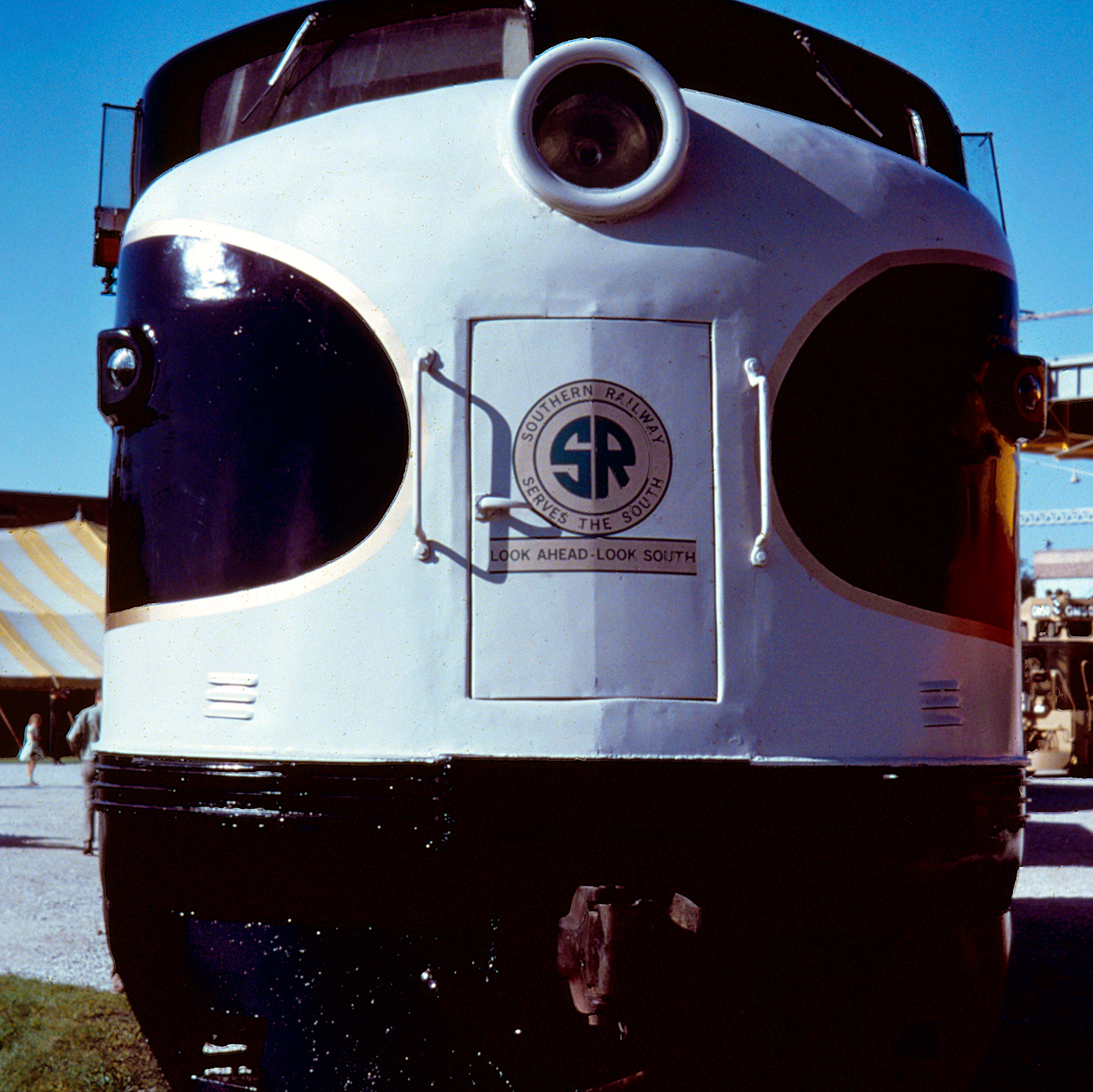 Southern Railway (CNO&TP) FTA #6100, part of the famous #103 demonstrator set that toured the country in 1939, sits on display at Electro-Motive's 50th Anniversary celebration open house at La Grange, Illinois; September 9, 1972. American-Rails.com collection.
Southern Railway (CNO&TP) FTA #6100, part of the famous #103 demonstrator set that toured the country in 1939, sits on display at Electro-Motive's 50th Anniversary celebration open house at La Grange, Illinois; September 9, 1972. American-Rails.com collection.Modern Network
In the succeeding years the Southern controlled even more properties although not all were retained such as the Mobile & Ohio and Chicago, Indianapolis & Louisville (Monon). Others, however, became important assets including the aforementioned Interstate Railroad and Central of Georgia, both acquired during the 1960's.
Backed by strong management and a diverse traffic base the Southern spent the 20th century greatly improving its network. Its slogan, “The Southern Gives A Green Light To Innovations," fit the company well.
It was quick to adopt new technologies that greatly improved efficiency such as Centralized Traffic Control (CTC) and double-tracked many miles of main line.
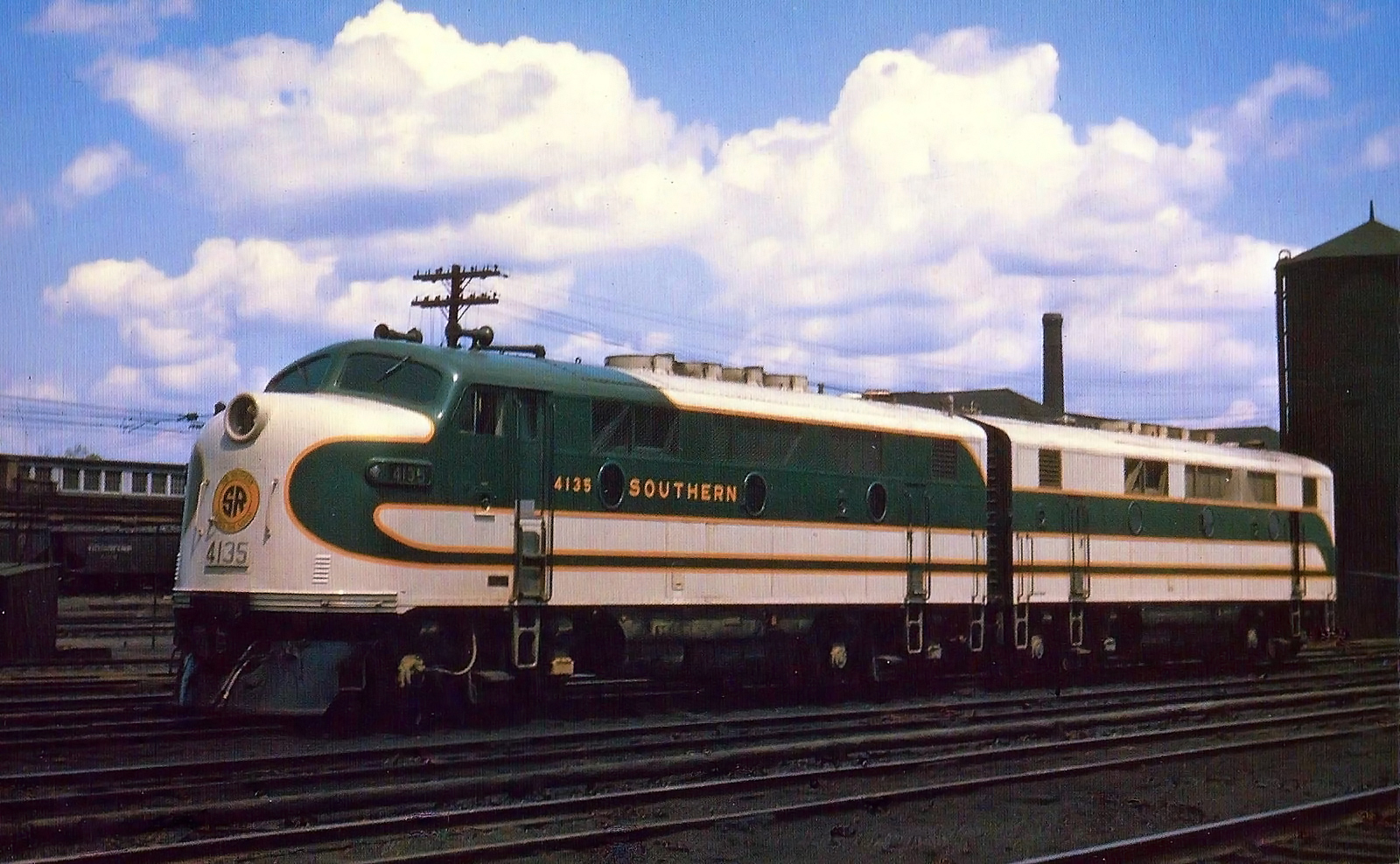 An A-B set of Southern Railway F3's in the company's original passenger livery layover at the Ivy City engine terminal in Washington, D.C. on May 14, 1947. When they first entered service these units handled runs between Washington and Atlanta. Leonard Rice photo. American-Rails.com collection.
An A-B set of Southern Railway F3's in the company's original passenger livery layover at the Ivy City engine terminal in Washington, D.C. on May 14, 1947. When they first entered service these units handled runs between Washington and Atlanta. Leonard Rice photo. American-Rails.com collection.Notable here included Washington to Atlanta, Cincinnati to Chattanooga, Birmingham to Meridian, and components south of Savannah. Dieselization also was adopted early; the railroad acquired its first examples in 1939 when new railcars arrived from the St. Louis Car Company (a notable builder of interurban equipment).
It then purchased its first road units in 1940 with Electro-Motive's game-changing FT cab model. By 1953 it had retired steam completely.
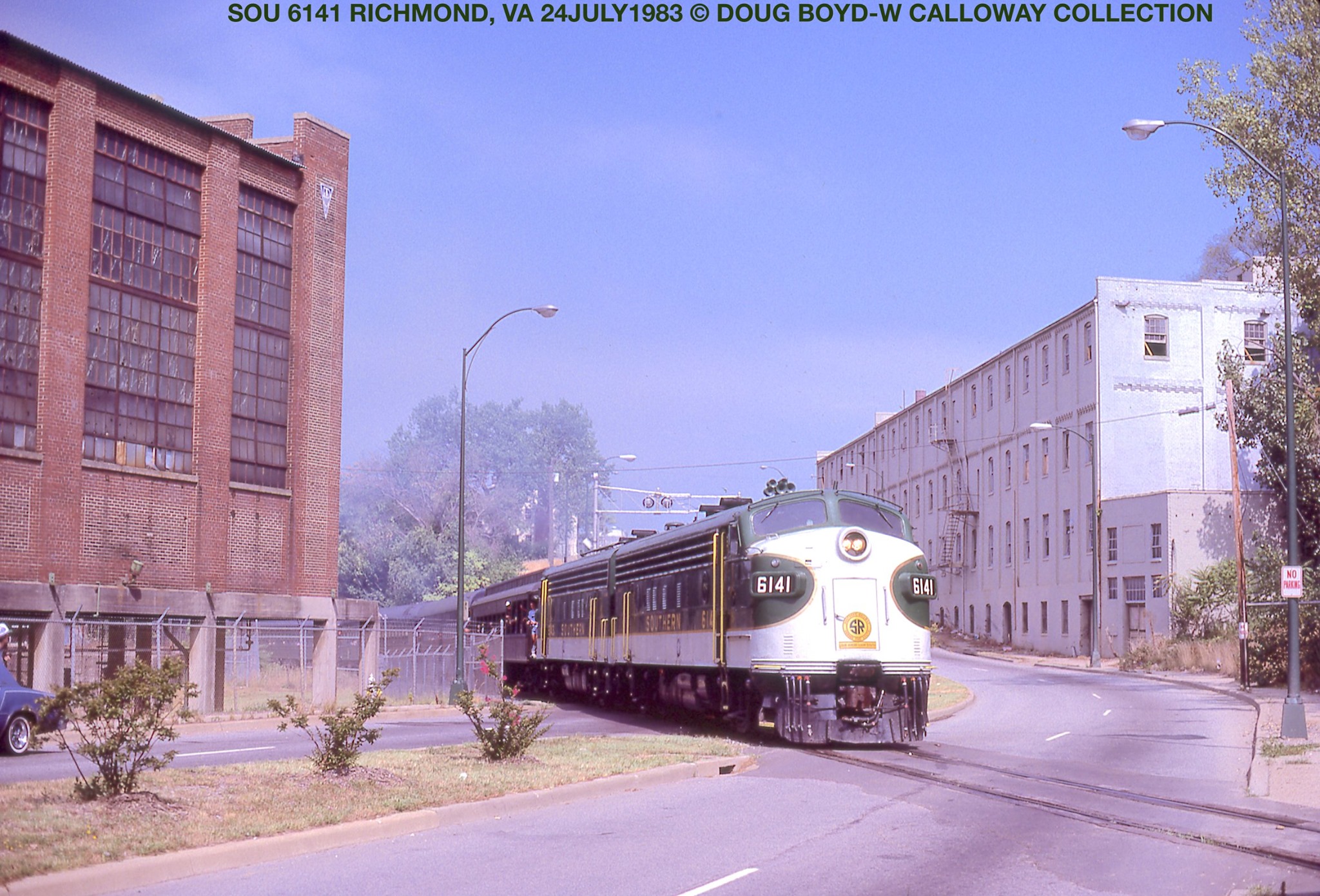 A pair of Southern Railway FP7's lead a special fan trip across Williamsburg Road in Richmond, Virginia on July 24, 1983. Doug Boyd photo/Warren Calloway collection.
A pair of Southern Railway FP7's lead a special fan trip across Williamsburg Road in Richmond, Virginia on July 24, 1983. Doug Boyd photo/Warren Calloway collection.During the steam era it rostered many wheel arrangements, from large to small. For example, big 2-8-8-2's were used on coal assignments out of the Appalachian Mountains of North Carolina, Tennessee, and Virginia (the Appalachia Division) while handsome 4-6-2's (Ps-4) carried the very best passenger trains it had to offer.
These Pacific's are best remembered for leading Southern’s flagship, the Crescent. They were adorned to match their trains in beautiful Virginia Green with white and gold trim. Fortunately one has been saved, #1401, which today resides at the Smithsonian where it is proudly displayed in its original livery.
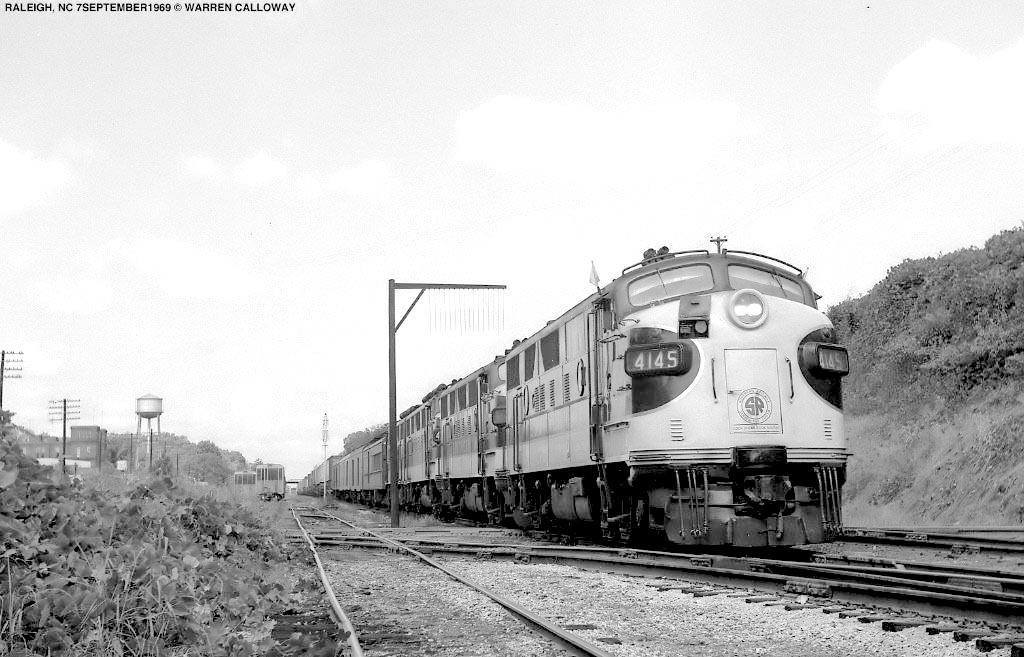 One of the Southern's famous late-era mixed trains, Extra 4145, rolls through Boylan Junction in Raleigh, North Carolina on September 7, 1969. Warren Calloway photo.
One of the Southern's famous late-era mixed trains, Extra 4145, rolls through Boylan Junction in Raleigh, North Carolina on September 7, 1969. Warren Calloway photo.Passenger Trains
Aiken-Augusta Special: (Washington - Salisbury - Augusta)
Asheville Special: (Washington - Greensboro - Asheville)
Birmingham Special: (Washington - Birmingham)
Carolina Special: (Cincinnati - Greensboro/Charleston)
Crescent: (New York-Washington-Atlanta-Montgomery-New Orleans)
Florida Sunbeam: (Cincinnati - Florida)
Kansas City-Florida Special: (Kansas City - Brunswick, Georgia/Florida)
Peach Queen: (Washington - Atlanta)
Pelican: (New York-Lynchburg-Bristol-Knoxville-Chattanooga-Birmingham-New Orleans)
Piedmont Limited: (Washington - New Orleans)
Ponce de Leon: (Cincinnati - Jacksonville)
Queen & Crescent: (Cincinnati - New Orleans)
Royal Palm: (Cincinnati-Chattanooga-Jacksonville)
Skyland Special: (Asheville - Jacksonville)
Southerner: (Washington-Atlanta-Birmingham-New Orleans)
Sunnyland: (Memphis - Atlanta)
Tennessean: (Washington-Lynchburg-Bristol-Knoxville-Chattanooga-Memphis)
Washington-Atlanta-New Orleans Express: (Washington - Atlanta - New Orleans)
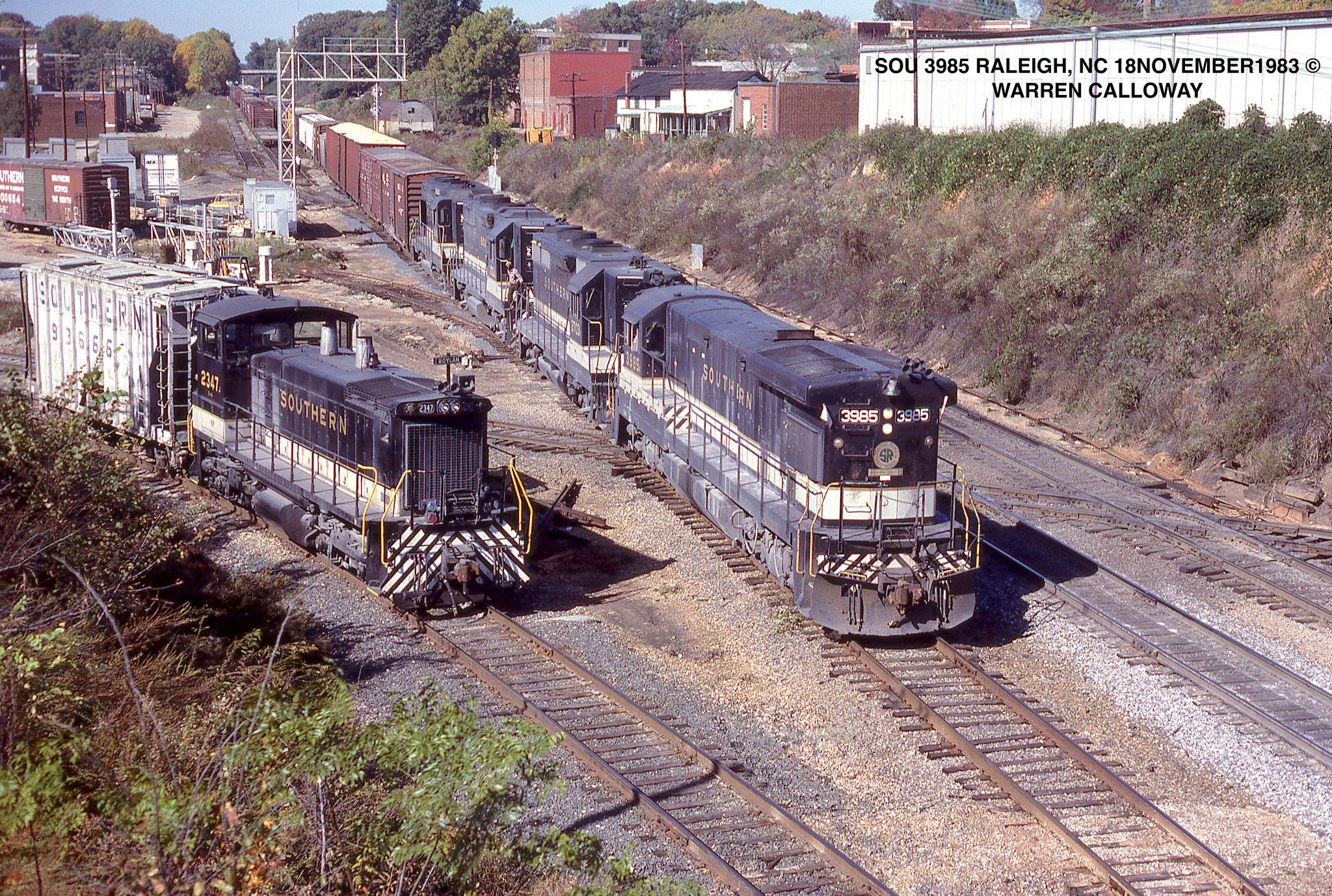 A busy scene at Boylan Junction in Raleigh, North Carolina during the early Norfolk Southern era on November 18, 1983. Warren Calloway photo.
A busy scene at Boylan Junction in Raleigh, North Carolina during the early Norfolk Southern era on November 18, 1983. Warren Calloway photo.Much of what made the company so successful were its many fine business leaders. It began with Samuel Spencer who helped piece together much of what became the Southern Railway.
Later Ernest Norris oversaw dieselization while Harry deButts understood how to sustain success in the postwar years. By the time D.W. Brosnan rose to the helm the company was already highly-respected.
Diesel Roster
American Locomotive Company
| Model Type | Road Number | Date Built | Quantity |
|---|---|---|---|
| S1 | 2000-2006, 6501-6502 | 1940-1941 | 9 |
| RS2 | 2101-2130 | 1949 | 30 |
| RS3 | 2025-2062, 2131-2145, 6208-6239, 6875-6882 | 1950-1953 | 93 |
| S2 | 2208-2232, 6057-6059 | 1941-1945 | 28 |
| DL-109 (A) | 2904 | 1942 | 2 |
| DL-110 (B) | 2954 | 1942 | 1 |
| S4 | 6074-6075 | 1951 | 2 |
| DL-107 (A) | 6400-6401 | 1941 | 2 |
| DL-108 (B) | 6400B-6401B | 1941 | 2 |
| PA-2 | 6900-6905 | 1953 | 6 |
Baldwin Locomotive Works
| Model Type | Road Number | Date Built | Quantity |
|---|---|---|---|
| VO-660 | DS-2005 | 1941 | 1 |
| VO-1000 | DS-2205 | 1941 | 1 |
| DS-4-4-1000 | 2285-2289 | 1948 | 5 |
| S12 | 2290-2299 | 1952 | 10 |
Electro-Motive Division
| Model Type | Road Number | Date Built | Quantity |
|---|---|---|---|
| GP9 | 302-303, 2500-2501, 6245-6249, 6898-6899, 8214-8215 | 1955-1956 | 13 |
| SW1 | 2002-2004, 2007-2011, 8565 | 1940, 1947 | 8 |
| GP7 | 2063-2077, 2156-2197, 6200-6205, 6240-6244, 6540-6544, 8210-8213 | 1950-1953 | 55 |
| NW5 | 2100 | 1947 | 1 |
| NW2 | 2200-2207, 2233-2284, 6050-6056, 6850-6851, 8560 | 1940-1948 | 68 |
| SW1500 | 2300-2347 | 1968-1970 | 48 |
| MP15DC | 2348-2435 | 1977-1982 | 88 |
| SD24 | 2502-2524, 6950-6953, 6305-6325 | 1959-1960 | 48 |
| GP30 | 2525-2644 | 1962-1963 | 120 |
| GP35 | 2526 (Second), 2641 (Second), 2645-2704 | 1965 | 62 |
| TR2 | 2400A-2404A (Cow), 2400B-2404B (Calf) | 1947 | 10 |
| GP38 | 2716-2878 | 1969-1971 | 163 |
| E6A | 2800-2802, 2900-2903 | 1941 | 7 |
| E6B | 2900B-2903B | 1941 | 4 |
| E7A | 2905-2922 | 1946-1949 | 18 |
| E8A | 2923-2929, 6906-6915 | 1951-1953 | 17 |
| SD35 | 3000-3099 | 1965-1966 | 100 |
| SD45 | 3105-3159 | 1967 | 55 |
| SD40 | 3170-3200 | 1971-1972 | 31 |
| SD40-2 | 3201-3328 | 1972-1979 | 128 |
| FTA | 4100A-4108A, 4100D-4108D, 4105B, 4105C, 4120-4127, 6100A-6102A, 6100D-6102D, 6800A-6803A | 1939-1945 | 38 |
| FTB | 4100B-4104B, 4100C-4104C, 4106B-4108B, 4106C-4108C, 4116-4119, 6100B-6102B, 6100C-6102C, 6800B-6803B | 1939-1945 | 30 |
| F3A | 4128-4206, 6106-6113, 6702-6713, 6804-6806 | 1946-1949 | 100 |
| F7A | 4207-4269, 6114-6120, 6714-6719 | 1949-1951 | 65 |
| F3B | 4320-4384, 6156-6159, 6750-6755, 6829 | 1946-1949 | 76 |
| F7B | 4385-4428, 6160-6183, 6756-6758 | 1949-1951 | 71 |
| GP39X | 4600-4605 | 1980 | 6 |
| GP38-2 | 5000-5256 | 1972-1979 | 257 |
| SW9 | 6060-6073, 6505-6509, 6852-6863, 8200-8203 | 1950 | 35 |
| FP7 | 6130-6149 | 1950 | 20 |
| F2A | 6700-6701 | 1946 | 2 |
| GP40X | 7000-7002 | 1978 | 3 |
| GP50 | 7003-7092 | 1980-1981 | 90 |
Fairbanks-Morse
| Model Type | Road Number | Date Built | Quantity |
|---|---|---|---|
| H16-44 | 2146-2155, 6545-6550 | 1950-1951 | 16 |
| H24-66 (Train Master) | 6300-6304 | 1954 | 5 |
General Electric
| Model Type | Road Number | Date Built | Quantity |
|---|---|---|---|
| 44-Tonner | 1950-1953, 6010, 6520, 6840 | 1945 | 7 |
| U30C | 3100-3104 | 1967 | 5 |
| B30-7A | 3500-3521 | 1982 | 22 |
| B36-7 | 3815-3820 | 1981 | 6 |
| U23B | 3900-3969 | 1972-1977 | 70 |
| B23-7 | 3970-4023 | 1978-1981 | 54 |
Steam Roster
The Southern's network was an interesting mix of stiff grades through the Appalachians and Carolina piedmont to a relatively flat profile along the coastal plains of South Carolina, Georgia, and Florida.
Whil the railroad's freight traffic was always quite diverse via its important Washington - New Orleans/Memphis and Cincinnati/New Orleans gateways, it also handled heavy coal traffic out of extreme western Virginia/eastern Tennessee.
As a result, its steam fleet was an eclectic mix of large examples like 2-10-2s and 2-8-8-2s to 2-8-2s and 2-8-0s, which handled most general freight.
The Southern became well known for the elegance and grace of its steam locomotives. Many, especially those leading passenger trains, were adorned in brass accents, stars on their cylinders, whitewall wheels, and everything polished to a high gloss.
In later years the railroad also painted several in a handsome Virginia Green livery with gold trim, as seen in the photo below by Shelby Lowe.
Because the Southern controlled or operated so many different railroads the company broke down its steam roster into a numbering series as follows:
- 1-5249: Southern Railway
- 6000-6499: Cincinnati, New Orleans & Texas Pacific Railway
- 6500-6696: Alabama Great Southern Rialroad
- 6800-6979: New Orleans & Northeastern Railroad
- 7000-7084: New Orleans Terminal Company
- 8000-8034: Russian Decapods
- 8200-8375: Georgia Southern & Florida Railway
- 8550-8556: St. John's River Terminal (Jacksonville, FL)
Class Ps4 (4-6-2)
Southern's Ps4 class has often been called one of the most beautiful Pacifics ever constructed featuring a long, graceful boiler, large drivers, and handsome livery of Virginia Green with white and gold trim adorning various aspects of the locomotives.
This was all accomplished years before the idea of streamlining became a popular concept and steamers. Prior to the 1930's, the industry paid little attention to the idea of dressing their trains in vibrant colors, let alone adorning them in a sleek appearance.
During that era they were viewed only as utilitarian; most locomotives were black and cars drab, "Pullman Green," brown, or some other dull pigment.
A few railroads, like the Baltimore & Ohio and Southern, went against the grain which led to the Ps4 variant. Thankfully, for history’s sake and the railfan community, the Southern recognized the significance of its Ps4 class and donated one to the Smithsonian Institution in 1961. You can still see her on display it continues to be displayed to this day.
The Ps4 was not the company's only group of 4-6-2s, actually very far from it. After the Chesapeake & Ohio put into service the first Pacific in 1902 the Southern was not far behind.
Just a few years later in 1905 it began operating its own design, listed as Class P. Short for Pacific, many railroads utilized a similar classification to designate its 4-6-2s. The wheel arrangement was also commonly used in passenger service.
On the Southern, this was no different where six large drivers provided sufficient power and speed during the early 20th century. Interestingly, in 1906 the railroad also acquired a handful for freight service.
In the end the Southern purchased there different batches of Pacific's which were assigned within the P class. The later variants were out-shopped through 1910 with six stenciled for subsidiary Georgia, Southern & Florida Railway.
These early Pacifics were built by a combination of manufacturers including Baldwin and the American Locomotive Company's (Alco) Richmond plant, totaling 72 units in all.
Between 1911 and 1914 the locomotives were rebuilt with superheaters and other upgrades, and were reclassified as Ps-2. Interestingly, the Ps4 class was the final batch of Pacifics the Southern owned and spanned nearly 10 years from the railroad's last order of 4-6-2s.
For instance, between 1905 and 1914 the company purchased or reclassified a total of seven different batches of Pacifics which included Class P, P-1, Ps-2, H/H1, H-1/Ps, H/H-2, and H/Ps-3. The Ps4 was not built until 1923 with most manufactured by Alco's Schenectady and Richmond plants.
These totaled 23 units (#1366-1392) and three years later in 1926 the railroad ordered 20 additional examples, which also came from Alco.
It was the arrival of the first batch that the world was exposed to the Southern's unveiling of elegant Virginia green. The livery was inspired from British railways, which were well-known for very elegant schemes adorning their locomotives.
While the Pacifics were draped mostly in deep green they also received gold and white pinstriping with white-wall wheels. Like the Baltimore & Ohio’s magnificent EM-1 locomotive class the Ps4s did not have a considerably long lifespan for a steam locomotive.
These were the only 4-6-2s, and only steamers within the Southern's entire fleet, to receive this special livery to haul the company's premier passenger runs of the period such as the Crescent.
After Alco delivered the last Ps4s in the late 1920s they survived less than thirty years before being retired in 1952 and replaced by the Electro-Motive Division’s (EMD) E7 diesel-electrics to pull the Southern’s premier passenger trains.
In regular service the Pacifics performed admirably with the job they were tasked. Sporting driving wheels of 73 inches they were capable of speeds approaching 80 mph with nearly 1,000 tons in tow on level track and regularly cruised the Southern’s Charlotte Division (between Washington, D.C. and Atlanta) main line at nearly 60 mph.
Finally, one Ps4, #1380, received streamlining and a special version of the Virginia green livery to power its new Southerner in 1941 between New York and New Orleans.
Thanks to the Southern's recognition of its history the railroad not only spared #1401 (among the last it purchased) but gave the locomotive a full cosmetic restoration in the late fall of 1961 before donating it to the Smithsonian. The new museum, where the Pacific is now on display, was completed and opened to the public in January of 1964.
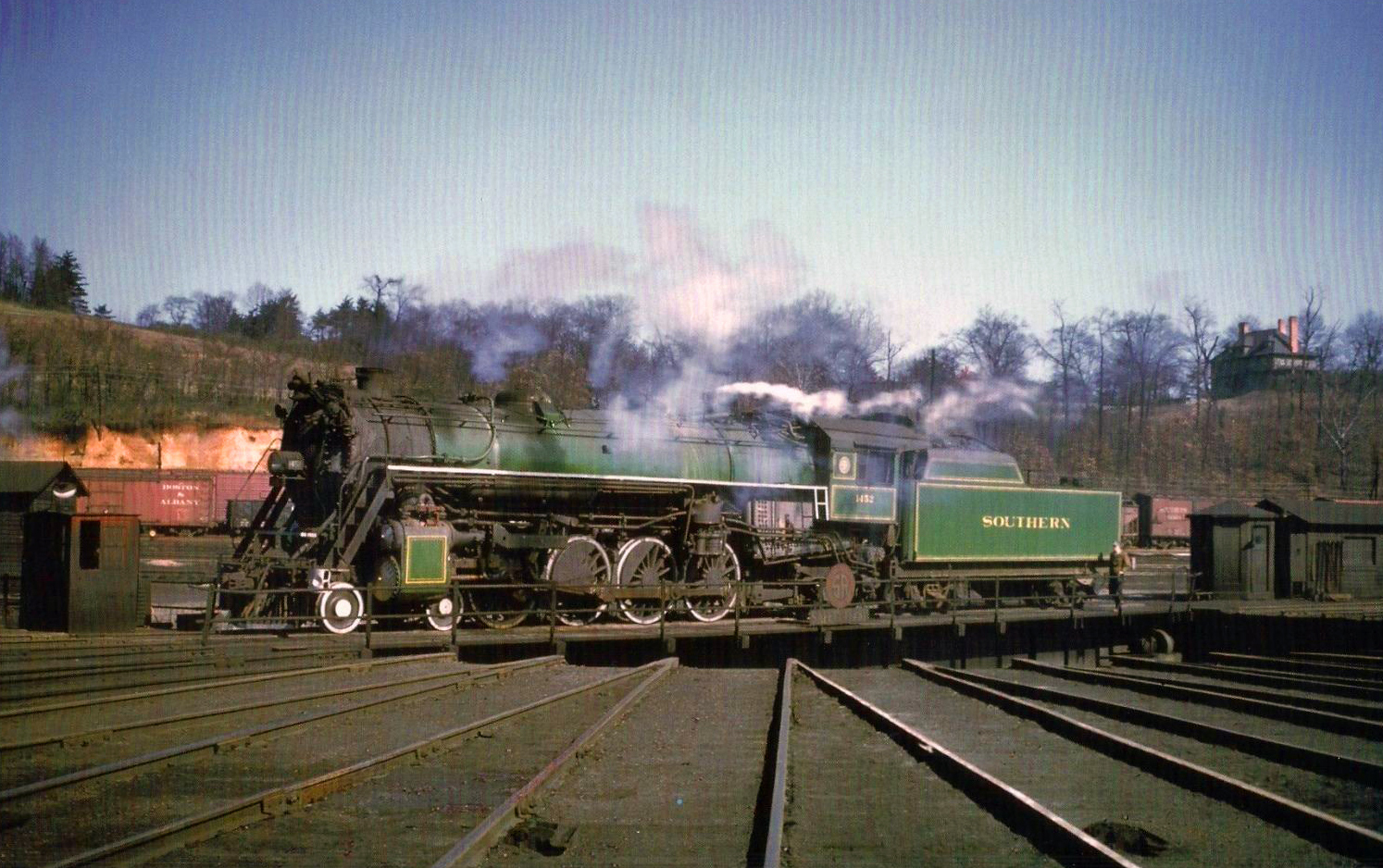 A beautiful Southern 4-8-2, #1452 (Class Ts), rides the turntable (note the company herald attached to the railing) at Asheville, North Carolina on February 8, 1950 shortly before its retirement. Shelby Lowe photo.
A beautiful Southern 4-8-2, #1452 (Class Ts), rides the turntable (note the company herald attached to the railing) at Asheville, North Carolina on February 8, 1950 shortly before its retirement. Shelby Lowe photo.Southern Railway
| Wheel Arrangement | Class | Road Number(s) | Quantity | Builder(s) | Completion Date | Retirement Date | Notes |
|---|---|---|---|---|---|---|---|
| 2-8-0 | - | 205-219 | 15 | Schenectady (Alco) | 1903, 1907 | 1933-1936 | - |
| 2-8-0 | H-1 | 251-252 | 2 | Richmond (Alco) | 1900 | 1934, 1938 | - |
| 2-8-0 | H-1 | 290-312 | 23 | Richmond (Alco) | 1900 | 1935-1952 | - |
| 2-8-0 | H-1 | 313-322 | 10 | Richmond (Alco) | 1901 | 1935-1952 | - |
| 2-8-0 | H-3 | 323-352 | 30 | Pittsburgh (Alco) | 1900 | 1933-1952 | - |
| 2-8-0 | H-1 | 353-377 | 25 | Baldwin | 1901 | 1933-1949 | - |
| 2-8-0 | H-4 | 378-402 | 25 | Baldwin | 1907 | 1933-1954 | - |
| 2-8-0 | J-1 | 403-408 | 6 | Baldwin | 1900 | 1933-1939 | - |
| 2-8-0 | J | 440-454 | 15 | Pittsburgh (Alco) | 1903 | 1933-1952 | - |
| 2-8-0 | J | 455-469 | 15 | Richmond (Alco) | 1902 | 1935-1950 | - |
| 2-8-0 | J-2 | 470-479 | 10 | Baldwin | 1902 | 1936-1950 | - |
| 2-8-0 | J | 480-489 | 10 | Baldwin | 1903-1904 | 1934-1950 | - |
| 2-8-0 | J | 505-548 | 44 | Pittsburgh (Alco), Baldwin | 1903 | 1934-1951 | - |
| 2-8-0 | J | 505-509 | 5 | Pittsburgh (Alco) | 1903 | 1933-1950 | - |
| 2-8-0 | J | 510-548 | 39 | Baldwin | 1903 | 1933-1950 | - |
| 2-8-0 | I | 549-552 | 4 | Pittsburgh (Alco) | 1907 | 1935-1938 | - |
| 2-8-0 | I | 553-556 | 4 | Baldwin | 1909 | 1934-1935 | - |
| 2-8-0 | Ks | 566-883 | 318 | Richmond (Alco), Baldwin, Pittsburgh (Alco) | 1903-1910 | 1935-1953 | - |
| 4-6-0 | F-7 | 915-917 | 3 | Baldwin | 1903 | 1933-1937 | - |
| 4-6-0 | F-7 | 915-918 | 4 | Baldwin | 1903 | 1933-1937 | - |
| 4-6-0 | F-8 | 919-928 | 10 | Baldwin | 1907 | 1933-1946 | - |
| 4-6-0 | F-11 | 1001-1040 | 40 | Schenectady (Alco), Richmond (Alco), Baldwin | 1899-1906 | 1929-1939 | - |
| 4-6-0 | F-11 | 1005-1008 | 4 | Richmond (Alco) | 1900 | 1929-1939 | - |
| 4-6-0 | F-11 | 1009-1018 | 10 | Baldwin | 1901-1902 | 1929-1939 | - |
| 4-6-0 | F-12 | 1051-1084 | 34 | Baldwin, Richmond (Alco) | 1897-1903 | 1928-1948 | - |
| 4-6-0 | F-12 | 1061-1074 | 14 | Richmond (Alco) | 1900-1901 | 1930s | - |
| 4-6-0 | F-14 | 1075 | 1 | Baldwin | 1902 | ca. 1948 | - |
| 4-6-0 | F-14 | 1085-1112 | 28 | Baldwin | 1903-1904 | 1933-1947 | - |
| 4-6-0 | F-16 | 1113 | 1 | Baldwin | 1914 | 1934 | - |
| 4-6-0 | Fs-17 | 1114 | 1 | Baldwin | 1914 | 1947 | - |
| 4-6-2 | Ps | 1200-1250 | 51 | Baldwin, Richmond (Alco) | 1903-1910 | 1938-1951 | 25 examples later upgraded as Class Ps-2. |
| 4-6-2 | P-1 | 1275-1299 | 25 | Baldwin | 1906 | 1935-1947 | - |
| 4-6-2 | Ps | 1300-1324 | 25 | Baldwin | 1910-1911 | 1937-1953 | - |
| 4-6-2 | Ps | 1360-1365 | 6 | Baldwin | 1910 | 1940-1952 | Formerly GS&F #500-505. |
| 4-6-2 | Ps-2 | 1251-1270 | 20 | Baldwin, Richmond (Alco) | 1911-1912 | 1947-1952 | - |
| 4-6-2 | Ps-2 | 1325-1359 | 35 | Richmond (Alco), Baldwin | 1912-1914 | 1946-1951 | - |
| 4-6-2 | Ps-4 | 1366-1409 | 44 | Schenectady (Alco), Richmond (Alco), Baldwin | 1923-1928 | 1949-1953 | - |
| 4-8-2 | Ts-1 | 1475-1499 | 25 | Baldwin, Richmond (Alco) | 1919 | 1952-1953 | - |
| 0-6-0 | A-3 | 1562-1565 | 4 | Baldwin | 1903 | 1929 | - |
| 0-6-0 | A-4 | 1566-1575 | 10 | Pittsburgh (Alco) | 1906 | 1925-1949 | - |
| 0-6-0 | A-4 | 1576-1600 | 25 | Baldwin | 1906 | 1927-1951 | - |
| 0-6-0 | A-8 | 1601-1607 | 7 | Baldwin | 1904 | 1933-1948 | - |
| 0-6-0 | A-7 | 1615-1751 | 137 | Baldwin, Pittsburgh (Alco), Lima | 1904-1914 | 1934-1953 | - |
| 0-8-0 | As-11 | 1839-1897 | 59 | Brooks (Alco), Richmond, Lima | 1918-1926 | 1952-1954 | Five examples later sublettered for the CNO&TP and one other for NO&NE. |
| 0-8-0 | As-10 | 1898-1899 | 2 | Baldwin | 1914 | 1953 | - |
| 4-4-2 | C | 1905-1914 | 10 | Richmond (Alco) | 1906 | 1934-1942 | - |
| 2-8-0 | Ks-3 | 2500-2509 | 10 | Richmond (Alco) | 1926 | 1952-1953 | - |
| 4-6-0 | Es-20 | 3458 | 1 | Schenectady (Alco) | 1900 | Formerly GS&F #137. | |
| Shay (Class D: 150-ton, 4-truck) | - | 1375-1376 | 2 | Lima | 1907 | Sold to the C&O in 1911. | Later numbered 4000-4001. |
| 2-6-8-0 | Ls | 4002, 4003 | 2 | Baldwin | 1911 | 1935 | - |
| 2-8-0 | Ls | 4002, 4003 | 2 | Baldwin | 1911 | 1935 | - |
| 2-8-8-2 | LS-1 | 4004-4026 | 23 | Baldwin | 1918-1926 | 1937-1950 | - |
| 2-8-8-2 | LS-2 | 4050-4058 | 9 | Baldwin | 1926, 1928 | 1951-1952 | - |
| 2-8-2 | Ms | 4501-4635 | 135 | Baldwin, Richmond (Alco) | 1911-1914 | 1939-1953 | - |
| 2-8-2 | Ms-1 | 4750-4774 | 25 | Schenectady (Alco), Richmond (Alco) | 1918, 1923 | 1951-1953 | - |
| 2-8-2 | Ms-4 | 4800-4914 | 115 | Richmond (Alco), Schenectady (Alco), Baldwin | 1923-1928 | 1952-1954 | - |
| 2-8-2 | Ms-6 | 4995-4997,4999 | 4 | Brooks (Alco) | 1918 | 1952 | Rebuilt from 2-10-2s. |
| 2-8-2 | Ms-5 | 4998 | 1 | Brooks (Alco) | 1918 | 1952 | Rebuilt from 2-10-2s. |
| 2-10-2 | Ss | 5000-5079 | 80 | Baldwin, Richmond (Alco) | 1917-1918 | 1938-1952 | - |
| 2-10-2 | Ss-1 | 5200-5249 | 50 | Baldwin, Richmond (Alco) | 1917-1918 | 1938-1952 | - |
| 2-10-0 | No Class | 8000-8019 | 20 | Richmond (Alco) | 1918 | - | Reassigned to other railroads in 1/1919. |
| 2-10-0 | - | 8025-8034 | 10 | Baldwin | 1918 | - | Reassigned to other railroads in 1/1919. |
Alabama Great Southern
| Wheel Arrangement | Class | Road Number(s) | Quantity | Builder(s) | Completion Date | Retirement Date | Notes |
|---|---|---|---|---|---|---|---|
| 0-6-0 | A-9 | 6501, 6502 | 2 | Baldwin | 1903 | 1932, 1929 | |
| 0-6-0 | A-7 | 6510-6519 | 9 | Pittsburgh, Richmond | 1905-1907 | 1936-1949 | |
| 0-6-0 | As-10 | 6530-6533 | 4 | Lima | 1917 | 1952-1953 | |
| 0-8-0 | As-11 | 6534-6537 | 4 | Lima | 1926 | 1953-1954 | |
| 2-8-0 | H-7 | 6550-6558 | 9 | Richmond (Alco), Baldwin | 1902-1903 | 1924-1938 | - |
| 2-8-0 | K | 6565-6595 | 31 | Richmond (Alco), Baldwin | 1905-1909 | 1939-1953 | - |
| 2-8-0 | Ks-1 | 6599 | 1 | Baldwin | 1909 | 1947 | - |
| 2-8-2 | Ms | 6600-6611 | 12 | Baldwin, Richmond (Alco), Lima | 1913-1917 | 1949-1950 | - |
| 2-8-2 | Ms-1 | 6612-6621 | 10 | Richmond (Alco) | 1922 | 1952-1953 | - |
| 2-8-2 | Ms-4 | 6622-6629 | 8 | Richmond (Alco) | 1926 | 1952-1954 | - |
| 2-8-2 | Ms-7 | 6630-6636 | 7 | Baldwin, Schenectady (Alco), Lima | 1911-1913 | 1949-1952 | ex-Erie Railroad |
| 2-6-8-0 | Ls | 6399 | 1 | Baldwin | 1909 | 1935 | - |
| 4-6-0 | 6654-6657 | 4 | Richmond (Alco) | 1900, 1902 | 1923-1928 | - | |
| 4-6-0 | E3 | 6660 | 1 | Schenectady (Alco) | 1905 | 1932 | - |
| 4-6-0 | E3 | 6661 | 1 | Baldwin | 1906 | 1931 | - |
| 4-6-2 | Ps | 6675-6683 | 9 | Baldwin, Richmond (Alco) | 1907, 1909 | 1939-1949 | - |
| 4-6-2 | Ps-4 | 6684-6691 | 8 | Schenectady (Alco), Richmond (Alco) | 1923, 1926 | 1949-1953 | - |
| 4-8-2 | Ts-1 | 6692-6694 | 3 | Baldwin | 1919 | 1952 | - |
| 4-8-2 | Ts | 6695-6696 | 2 | Baldwin | 1917 | 1954, 1948 | - |
Cincinnati, New Orleans & Texas Pacific
| Wheel Arrangement | Class | Road Number(s) | Quantity | Builder(s) | Completion Date | Retirement Date | Notes |
|---|---|---|---|---|---|---|---|
| 0-6-0 | - | 6000-6012 | 11 | Baldwin, Pittsburgh (Alco), Dickson (Alco) | 1900-1904 | 1922-1939 | - |
| 0-6-0 | A-7 | 6015-6020 | 6 | Pittsburgh (Alco), Richmond (Alco) | 1906-1907 | 1935-1948 | - |
| 0-8-0 | As-10 | 6025-6028 | 4 | Lima | 1917 | 1952 | - |
| 0-8-0 | As-11 | 6029-6033 | 5 | Brooks | 1918 | 1952-1954 | Formerly lettered as Southern #1878-1880 and #1891-1892. |
| 0-8-0 | As-11 | 6034-6045 | 10 | Baldwin, Lima | 1922, 1926 | 1952-1954 | - |
| 0-8-0 | G-4 | 6101-6179 | 79 | Rhode Island (Alco), Schenectady (Alco), Pittsburgh (Alco), Baldwin | 1899-1903 | 1923-1934 | - |
| 2-8-0 | Ks | 6180-6229 | 50 | Richmond (Alco), Baldwin | 1905-1911 | 1939-1950 | 13 examples relettered as NO&NE. |
| 2-8-2 | Ms | 6250-6284 | 35 | Baldwin | 1911, 1913 | 1949-1953 | - |
| 2-8-2 | Ms-4 | 6285-6319 | 35 | Schenectady (Alco), Richmond (Alco) | 1918, 1922 | 1952-1953 | - |
| 2-8-2 | Ms-4 | 6320-6337 | 18 | Richmond (Alco) | 1926 | 1953-1954 | - |
| 2-8-2 | Ms-4 | 6350-6374 | 25 | Baldwin | 1928 | 1952-1954 | - |
| 4-6-0 | AC4 | 6420-6423 | 4 | Baldwin | 1903, 1906 | 1924, 1927 | - |
| 4-6-2 | Ps | 6450-6470 | 21 | Richmond (Alco), Baldwin | 1907-1913 | 1938-1951 | - |
| 4-6-2 | Ps-4 | 6471-6482 | 12 | Schenectady (Alco), Richmond (Alco) | 1924, 1926 | 1952-1953 | - |
| 4-8-2 | Ts | 6490-6494 | 5 | Baldwin | 1917 | 1951-1953 | - |
| 4-8-2 | Ts-1 | 6495-6499 | 5 | Richmond (Alco), Baldwin | 1919 | 1951-1953 | Formerly lettered as Southern #1495-1498 and #1475. |
Georgia Southern & Florida Railway
| Wheel Arrangement | Class | Road Number(s) | Quantity | Builder(s) | Completion Date | Retirement Date | Notes |
|---|---|---|---|---|---|---|---|
| 4-4-0 | B-14 | 8200-8202 | 3 | Baldwin | 1900 | 1928, 1932 | - |
| 4-4-0 | B-16 | 8210-8213 | 4 | Schenectady (Alco) | 1900-1901 | 1929-1934 | - |
| 4-6-0 | Fs-11 | 8230-8233 | 4 | Baldwin | 1906-1907 | 1929-1938 | - |
| 4-6-0 | Fs-17 | 8250-8257 | 8 | Baldwin | 1914-1915 | 1947-1949 | - |
| 4-6-0 | Es-20 | 8300-8305 | 6 | Schenectady (Alco), Baldwin | 1900-1904 | 1928-1939 | - |
| 2-8-0 | Ks | 8330-8338 | 9 | Baldwin | 1910 | 1951-1952 | - |
| 2-8-0 | Ks-1 | 8339-8344 | 6 | Richmond (Alco) | 1912 | 1949-1953 | - |
| 0-6-0 | A-7 | 8370-8375 | 6 | Baldwin, Richmond (Alco) | 1910, 1912 | 1948-1953 | - |
New Orleans & Northeastern
| Wheel Arrangement | Class | Road Number(s) | Quantity | Builder(s) | Completion Date | Retirement Date | Notes |
|---|---|---|---|---|---|---|---|
| 0-6-0 | A-8 | 6815-6826 | 12 | Baldwin, Richmond (Alco) | 1901-1907 | 1928, 1934 | - |
| 0-8-0 | As-11 | 6849 | 1 | Brooks (Alco) | 1918 | 1952 | - |
| 4-6-0 | Es-21 | 6875-6885 | 11 | Baldwin | 1904-1907 | 1928-1940 | - |
| 4-6-0 | Es-22 | 6886-6888 | 3 | Baldwin | 1911-1912 | 1946-1948 | - |
| 4-6-0 | Es-23 | 6889-6891 | 3 | Baldwin | 1912 | 1940, 1948 | - |
| 4-6-0 | Es-22 | 6892, 6893 | 2 | Baldwin | 1912 | 1947 | - |
| 4-6-0 | Fs-21 | 6894-6895 | 2 | Baldwin | 1912 | 1939 | - |
| 2-8-0 | Hs-6 | 6898-6899 | 2 | Baldwin | 1910 | 1949 | - |
| 2-8-0 | Ks | 6900-6911 | 12 | Baldwin, Richmond (Alco) | 1906-1911 | 1939-1951 | ex-CNO&TP |
| 2-8-0 | Ks | 6915 | 1 | Baldwin | 1907 | 1950 | ex-CNO&TP |
| 2-8-0 | Ks | 6920, 6921 | 2 | Richmond (Alco), Baldwin | 1905, 1907 | 1951, 1950 | ex-CNO&TP |
| 2-8-0 | Ks-4 | 6922-6926 | 5 | Baldwin | 1914 | 1949-1952 | - |
| 2-8-2 | Ms-3 | 6940-6944 | 5 | Baldwin | 1914, 1916 | 1946 | - |
New Orleans Terminal
| Wheel Arrangement | Class | Road Number(s) | Quantity | Builder(s) | Completion Date | Retirement Date | Notes |
|---|---|---|---|---|---|---|---|
| 0-6-0 | 7071-7077 | 7 | Baldwin | 1905 | 1923-1936 | - | |
| 2-6-0 | 7080-7084 | 5 | Baldwin | 1905 | 1933-1937 | - |
St. Johns River Terminal Company
| Wheel Arrangement | Class | Road Number(s) | Quantity | Builder(s) | Completion Date | Retirement Date | Notes |
|---|---|---|---|---|---|---|---|
| 0-6-0 | A-4 | 8550-8551 | 2 | Baldwin | 1908, 1909 | 1941, 1947 | |
| 0-6-0 | A-7 | 8555-8556 | 2 | Baldwin, Lima | 1909, 1912 | 1953 | - |
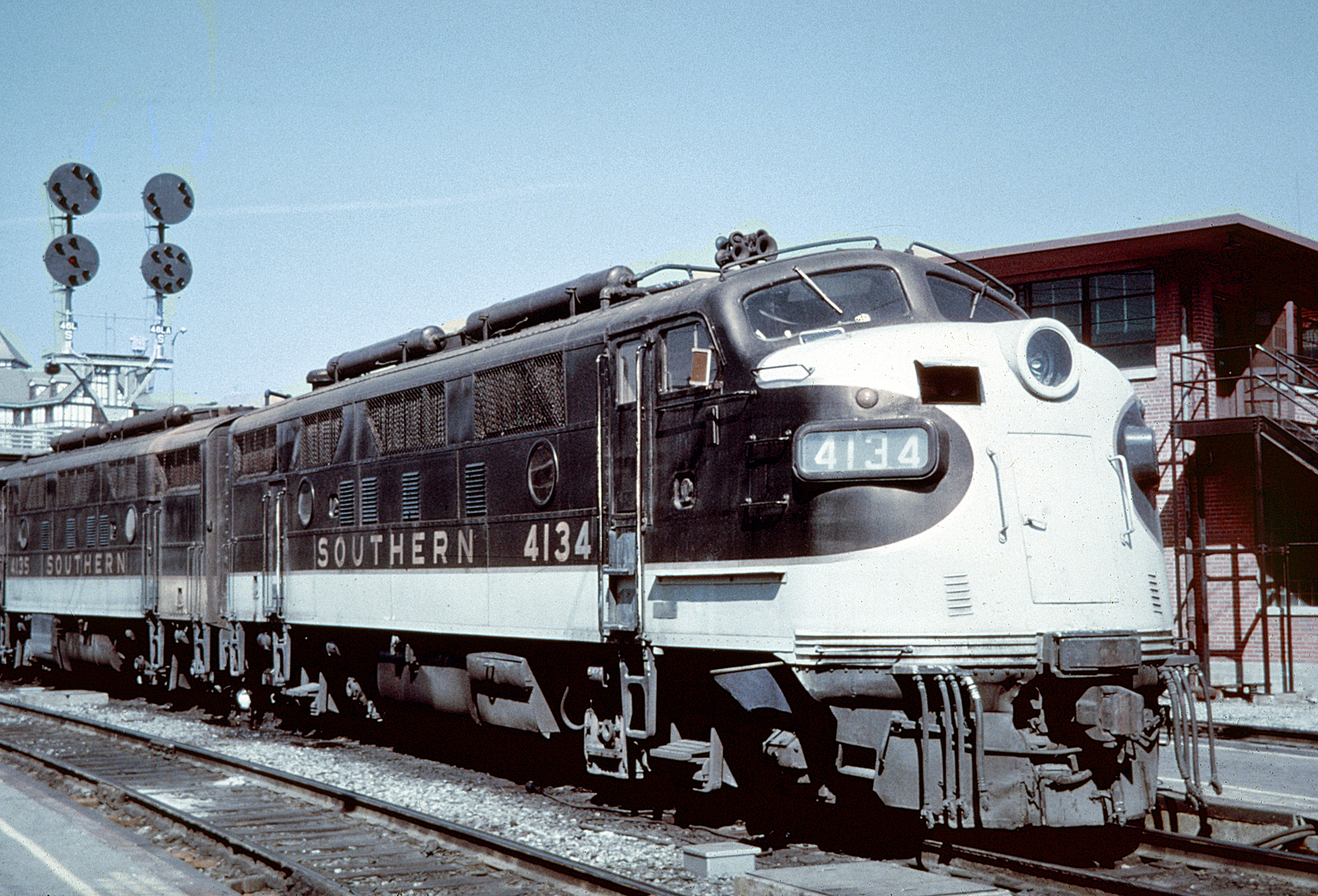 Southern F3's in Roanoke, Virginia on the Norfolk & Western; April 4, 1967. American-Rails.com collection.
Southern F3's in Roanoke, Virginia on the Norfolk & Western; April 4, 1967. American-Rails.com collection.Norfolk Southern
Brosnan added yet more new technologies and improved operations in such areas as eliminating known bottlenecks and utilizing computers. Graham Claytor, Jr. was the next-to-last president and carried out things much as his predecessors had done before him.
In the Southern’s final days under L. Stanley Crane operations hummed along even as the industry hit an all-time low.
In 1981, the road's last full year of independence it earned nearly $1.8 billion in revenues. The urgent union with Norfolk & Western was approved by the Interstate Commerce Commission in 1982 and today Norfolk Southern Corporation carries on the fine traditions set forth by its predecessors.
The company is still renowned for its sound management and business practices. It continually ranks at the top of the industry in annual revenue and a low operating ratio.
During the 1990s another fight broke out with CSX, this time for control of Conrail. In the end the two agreed to split Big Blue with NS gaining a 58% stake in the company leaving the eastern United States with only two Class I railroads.
Timetables (August, 1952)
Contents
Cincinnati, New Orleans & Texas Pacific
Georgia Southern & Florida Railway
Recent Articles
-
Hawaii Christmas Train Rides On Oahu!
Dec 04, 25 10:45 PM
Hawaii Christmas Train Rides On Oahu! -
Louisiana's Christmas Train Rides
Dec 04, 25 10:35 PM
Here, we explore some of the most popular Christmas train rides across Louisiana, each offering its own slice of yuletide wonder. -
Wisconsin Murder Mystery Train Rides At NRM!
Dec 04, 25 11:50 AM
The Mystery Express is NRM’s signature murder-mystery event, staged in and around its historic equipment.

